- Buy the Book…
- Reviews Hub


the m0vie blog

Following Us
- Adding Our RSS Feed to Your Gmail
- Following our Feed in Internet Explorer
- Millennium (Reviews)
- Star Trek: Deep Space Nine (Reviews)
- Star Trek: Enterprise (Reviews)
- Star Trek: The Next Generation (Reviews)
- Star Trek: The Original Series (Reviews)
- Star Trek: Voyager (Reviews)
- The X-Files (Reviews)
- X-Files Fandom Poll Form
Check out the Archives

Awards & Nominations

Star Trek: Voyager – Fury (Review)
Normally, the return of an old cast member to an established show is a cause for celebration, akin to a belated family reunion.
The obvious examples involve the appearances of cast members from other shows on later spin-offs. Think of the reverence and sincerity with which Star Trek: The Next Generation treated Spock and Scotty in episodes like Unification, Part I , Unification, Part II and Relics . Think about the delight with which Star Trek: Voyager greeted Geordi LaForge in Timeless or Deanna Troi in Pathfinder . Even when Star Trek: Deep Space Nine subverted expectations with Jonathan Frakes’ appearance in Defiant , it was still joyful. If anything, Star Trek: Enterprise went too far in accommodating Troi and Riker in These Are the Voyages…
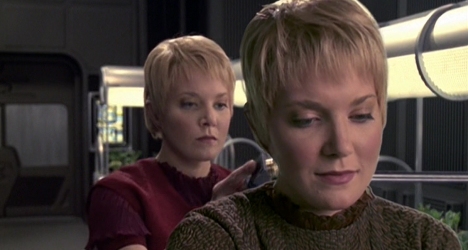
Self-control.
Even within individual shows, the return of long-absent cast members is often treated as an opportunity to celebrate that character, and perhaps even to acknowledge past missteps involving them. Yesterday’s Enterprise brought back the character of Tasha Yar, and used the opportunity to rewrite her mean-spirited and pointless death in Skin of Evil . When mirror! Bareil visited in Resurrection , the episode became a meditation upon how the character’s intrinsic decency was strong enough to transcend dimensions and to define even the worst version of himself.
This approach to the return of established characters makes a great deal of sense for a wide variety of reasons. Most obviously, the production team have gone out of their way to recruit these actors for this specific purpose; it makes sense that these episodes should serve as a celebration of their contributions to the franchise. Even beyond that, it is safe to say that almost any lead character on a Star Trek series has something resembling a fan base; think about the ominously-named “Friends of Vedek Bareil.” Why bring back a character, and attract in those fans, just to do something horrific?
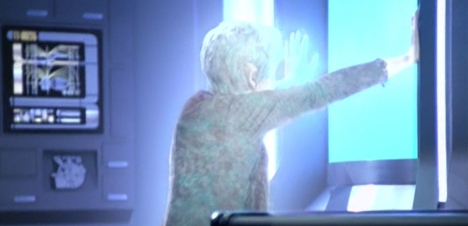
That healthy blue glow.
All of this serves to make Fury all the more perplexing. Fury is an episode of Voyager that effectively resurrects the character of Kes, a regular on the first three seasons of Voyager who departed the series in The Gift at the start of the fourth season. The return of Kes is a strange choice, in large part because the production team often struggled with what to do with the character while she was part of the core cast. Still, there are any number of interesting possibilities. And there is the possibility that, like Yesterday’s Enterprise or Resurrection , the production team might use the occasion to say something interesting about Kes.
Unfortunately, Fury is a spectacular mess of an episode with half-developed character motivations and a highly surreal premise that undercuts a lot of the appeal of bringing Kes back in the first place.

Having its cake and eating it too.
To be fair, Fury is very much in keeping with the broad aesthetic of the sixth season of Voyager . In some ways, the sixth season of Voyager feels more like a final season than the seventh, so preoccupied is the season with questions of legacy and mortality. Repeatedly, the sixth season of Voyager asks the question of how Voyager (and perhaps Star Trek itself) will be remembered, whether as the aspirational object in Blink of an Eye or as the source of legend in Muse or as parodied by con men in Live Fast and Prosper .
Similarly, the sixth season has a recurring preoccupation with mortality, perhaps befitting a series heading towards its own preordained final season and a franchise that was clearly in decline. Barge of the Dead sent Torres into the afterlife; Dragon’s Teeth featured the resurrection of a dead civilisation; One Small Step had the crew discovering a floating museum piece with a mummified corpse; Life Line sends the EMH home to visit his dying father. As such, Fury makes a great deal of sense, focusing as it does on the return of a dying Kes.
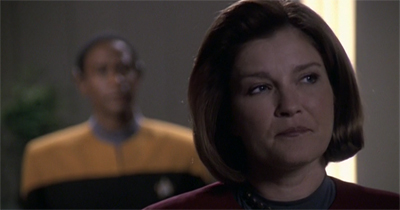
Giving Tuvok a wide birth(day).
Indeed, this theme is suggested as early as the opening scene, before Kes attacks the ship. In this introductory sequence, Janeway surprises Tuvok by presenting him with a birthday cake. Birthdays serve as markers of time, and of mortality. They serve to remind people that time flows in one direction and towards one inevitable reality. “So, it’s not long before you hit the big three digits, huh?” Janeway jokes, a reminder that even a Vulcan like Tuvok is not immune from the ravages of time. Fury is very much invested in the idea of the toll that time takes.
To be fair, Fury hints at one of the many unfulfilled promises made with Kes as a character. In Caretaker , Kes was introduced as a character with a very short lifespan, with most Ocampans living until about the age of nine. This short lifespan made certain aspects of her character creepy and uncomfortable, such as Neelix’s possessiveness towards her in episodes like Twisted or Paris’ attraction towards her in Parturition . However, it also added an interesting premise to what might otherwise be a stock character.
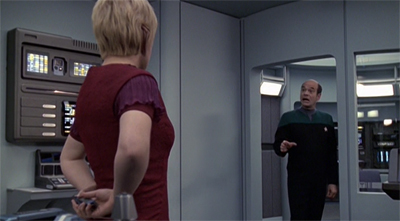
Injecting a little drama.
As Kes was about two years old when she joined the crew, Caretaker seemed to tease that Kes would grow and age over the remaining seven seasons of Voyager , and that the audience would effectively get to see her live her entire life from beginning to end in the one-hundred-and-seventy-odd episodes that the production team could safely assume that Voyager would run. Much like the tension between Starfleet and the Maquis, and much like the challenges of surviving alone in a hostile region, the character of Kes demanded long-form plotting and serialised storytelling from Voyager .
Of course, this never actually materialised. As early as Parallax and Time and Again , the show retreated from the idea of telling extended stories and allowing its characters to grow or develop between episodes. As a result, the ambitious premise underpinning Kes would be largely cast by the wayside, outside of occasional nods in episodes like Elogium or Before and After . Like most of the rest of the cast, Kes seemed frozen in time once the end credits rolled in Caretaker , give or take a hairstyle and costume change in the middle of the third season.
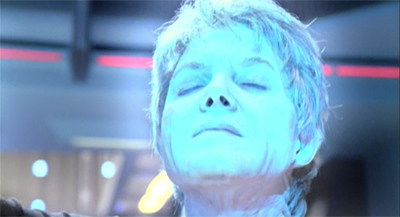
Kes has repeated her frustrations until she was blue in the face.
Between Caretaker and The Gift , Kes spent three years on Voyager. Even accepting that the audience doesn’t know how Ocampa actually age, that accounts for a third of her natural lifespan. In human terms, that would be equivalent to about thirty years. However, in those three years, the character only physically aged the human equivalent of three years, with the production team never really emphasising her accelerated aging or her ticking biological clock. There was perhaps a cynical motivation at work here, a desire to keep Jennifer Lien looking young and conventionally attractive.
In its own weird way, Fury delivers on the basic premise of Kes by allowing the character to age and confront her mortality. Of course, it isn’t exactly what Caretaker promised, and it seems difficult to reconcile with her ascent to higher plane of existence in The Gift , but it still represents a more sincere attempt to deliver on this idea than anything in the three seasons that Kes spent as a regular character. The teaser establishes the toll that time has taken on Kes as horrific, Janeway taken aback at the lines and wrinkles on her old friend’s face. “Kes?” she asks, almost not recognising the former crew member.
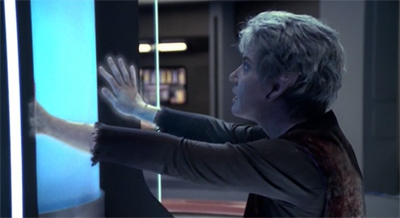
Betraying her core values.
There is no small irony in this. Voyager is a series that has often seemed frozen in time, trapped in a particular moment. Counter-intuitively for a television series about a journey from one clearly demarcated point to another, Voyager often seems static. Characters rarely change or grow. Harry Kim spends seven years as an ensign. Torres spends seven years struggling with her anger issues. The EMH never picks a name that sticks. It is no wonder that Kes had be ejected from Voyager , her very premise was hostile to the show itself.
So in Fury , through the reintroduction of a vengeful Kes, time seems to intrude into Voyager . Not just in the time travel back to the early days of the first season, but time in the way that real people seem to understand. Time that changes people, time that brings regrets, time that erodes bodies. Fury suggests that once Kes left Voyager she was subject to the ravages of time, even as a being of seemingly incredible power. Even after ascending to another plane of existence, Kes cannot halt the flow of time as effectively as the crew of Voyager seem to have done.
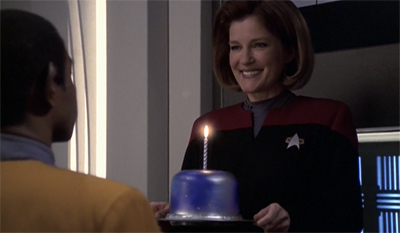
Let them eat cake.
Fury suggests that the crew of Voyager exist outside the flow of time, an idea that Voyager has suggested repeatedly in episodes like Blink of an Eye or Timeless . It is telling that Fury positions Tuvok as the crew’s narrative counterweight to Kes, and not just because he’s another vaguely telepathic alien with pointed ears. Tuvok is the antitheses of Kes. Kes is vulnerable to the flow of time, her body aging ten times faster than that of a regular human. Tuvok is immune to such ravages, approaching one hundred years of age without a wrinkle to show for it.
Fury aligns Kes and Tuvok as two extremes. Kes represents the flow of time, the reality of entropy and decay. Tuvok suggests a more static pace of living, a character who is so insulated from the toll that time exacts that he can bridge literal generations of the franchise in Flashback . It reveals a lot about Voyager as a television show that Fury presents Kes as its villain and Tuvok as its hero, treating the intrusion of time into its narrative framework as an inherently hostile and subversive act that runs the risk of completely breaking the series.

The Vulcan time forgot.
It should be noted that this is not just a reading imposed from outside the episode looking on. On returning to the set after being away for two-and-a-half seasons, Lien herself noticed how time had seemed to stand still for her old friends on the set of Voyager :
Jennifer admitted that it was very exciting to come back and commented on how she dealt with returning to a show that she used to appear on a weekly basis. “Things pretty much still seem the same here,” she commented. “It just feels like [I’ve been gone] a day. It doesn’t feel like any time has passed, whereas in my own personal life, time has passed and I can definitely feel that.”
Time is something that passes out in the real world, but not on Voyager . This might account for how it could feel like shows like The X-Files , Babylon 5 and The Sopranos had all left Voyager standing in the dust as they marched with the times and Voyager remained in place.
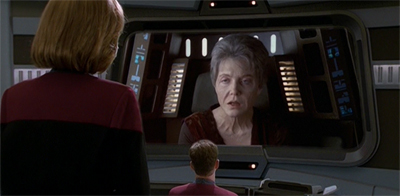
An old familiar face.
There is something implicitly defensive in how Fury treats Kes, as if the production team are trying to justify the stale and static nature of Voyager . In this respect, it is very similar to the engagement with the concept of serialisation and long-form storytelling in The Voyager Conspiracy , where Seven of Nine’s attempts to fashion a singular over-arching narrative for the five-and-a-half season run of Voyager is treated as borderline psychotic and dangers to many of the core assumptions underpinning the series as a whole.
The sixth season of Voyager occasionally grapples with criticisms of the show, acknowledging challenges that the production team have faced over the course of the show’s run. Sometimes these results are fascinating, as when Seven of Nine challenged Janeway’s conservatism in Child’s Play . Sometimes the results are awkward, such as Equinox, Part I and Equinox, Part II , which seem to present a challenge to Janeway’s rigid moral absolutism, only to unquestioningly reinforce her refusal to compromise to account for the ship’s unique situation.
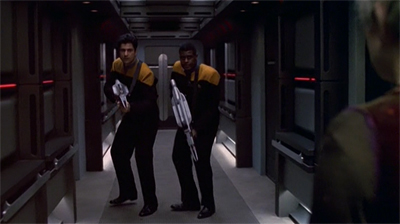
Ayala good things…
Episodes like The Voyager Conspiracy and Fury read as defensive screeds, episodes written to acknowledge long-standing and oft-discussed issues with the storytelling on Voyager , only to introduce those elements and present them as monstrous and horrific. The Voyager Conspiracy reads as a defense of the series’ happy-go-lucky episode-to-episode plotting ahead of more up-to-date serialised plotting like that seen on Deep Space Nine . Similarly, Fury brings back a character who has experienced the passage of time denied to the Voyager ensemble, only to reveal that the experience has horrifically scarred her.
This anxiety is reinforced through the episodes fear of change. It is suggested that Kes’ psychological breakdown happened because she was not ready to change as much as she did. “In three years, I’m going to leave Voyager in search of higher things because you encouraged me to do it,” Kes tells Janeway. “I wasn’t ready for what I found. I couldn’t control it. It scared me. I had nowhere to go. I thought of returning home to Ocampa, but I’d changed too much. I knew they’d be frightened of me. I knew they wouldn’t accept me, but they’ll accept her.”

Engineering a redemption.
Even at the end of Fury , when Kes has reconciled herself with the crew and made peace with her existence, Fury still appeals for a return to the familiar. Kes ends the episode by setting a course for the Ocampan homeworld, which is more than thirty-five thousand light years away. It seems safe to suggest that almost everybody she ever knew on the planet will be dead, and those who are still alive will be dying. In theory, Kes’ family should be the crew on Voyager. Kes should be spending her last days with the people whom she loved, the family that she found.
Of course, contractual obligations make this impossible. Jennifer Lien could never return to Voyager full-time, although perhaps the production team could have made her a recurring guest star. Instead, Kes has to leave the ship again and return to a world on which she has spent very little time. Indeed, a significant amount of Kes’ time on the Ocampan homeworld was spent in slavery to the Kazon. As such, there is a strong reactionary subtext to Fury , one which rejects the open-mindedness of Child’s Play . Found family, Fury insists, can never trump biological family. Even if those biological family members are strangers.
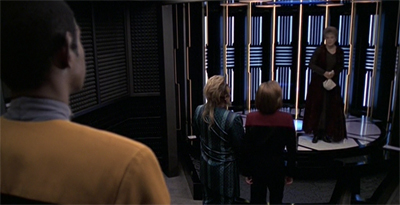
Feels like going home.
It should be noted that Kes’ decision to return to the Ocampan homeworld in Fury mirrors Neelix’s decision to remain with the Talaxian miners in Homestead . As Voyager approaches the end of its run, there is a strong sense that its Delta Quadrant characters should go where they “belong” rather than making a new home on Earth with their found family. This is reflected in the way in which all the Borg children (with the exception of Icheb) are casually dumped off the ship in Imperfection . It’s not too hard to reconcile this with the reactionary politics of episodes like Displaced or Day of Honour .
Fury is interesting because it marks the return of a character who departed the series. These sorts of episodes are relatively rare on Star Trek , in large part because there’s relatively little attrition in the franchise. Star Trek only added cast members as it developed. The Next Generation lost both Tasha Yar and Wesley Crusher, although it did bring both Denise Crosby and Wil Wheaton back repeatedly in the years that followed. Deep Space Nine lost Jadzia Dax in Tears of the Prophets at the end of its penultimate season, and the writers could only include a voice cameo (via recorded material) in Penumbra during the final season.

Kes of death.
According to an interview with Cinefantastique , Rick Berman developed Fury around the idea of bringing Jennifer Lien back:
“Before we even sat down and worked out the story, we spoke to her and wanted to really be sure that she wouldn’t be uncomfortable coming back. We also, I think, convinced her that it was a terrific story, and thus a good reason to bring Kes back. She came in and did a great job.”
This is interesting, because it hints at a weird nostalgia within the series itself, where the desire was to bring Kes back as an end of itself.
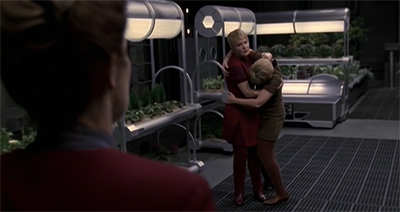
She really picked herself up.
It is interesting that the plotting of Fury worked in this manner, with the story reverse-engineered from the desire to bring the long-absent character back. It is not as though the production team were developing a story and realised that Kes would be a good fit for it. Instead, they consciously decided to bring back the character of Kes and then built an entire episode around that premise. It is certainly an interesting approach, even if it makes the rather mean-spirited nature of Kes’ return seems especially vindictive.
It would be one thing to have awkwardly slotted Kes into a preexisting story template, the contours of her character arc shaped by decisions that the writers had made long before they decided that the character in question was going to be Kes. This is, after all, how the writers on Enterprise approached the character of Arik Soong in Borderland , Cold Station 12 and The Augments . The original plan had been to use the character of Colonel Green from The Savage Curtain , but the part was reworked when Brent Spiner suggested he would be open to appearing on the series.
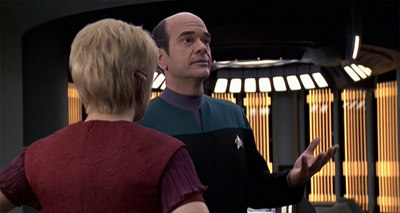
What’s up, Doc?
Instead, Fury was built around the idea that bringing back Kes was a desirable end of itself. As Bryan Fuller explained to Cinefantastique , the writers then tried to design a story that justified her return:
“Rick Berman wanted to bring her back. Rick made a phone call to Jennifer and said, ‘Would you like to do the show again?’ and she said, ‘Yes.’ He put it in the writing staff’s hands to come up with an idea for her to come back. Brannon spearheaded the story, so it came out quite nicely.”
Ignoring the surreal decision to tell this precise story to mark the return of a long-absent cast member, it is an interesting approach to storytelling. It suggests that perhaps Fury was driven by a high-concept more than a single narrative idea, a criticism that might be levelled at other episodes like Tsunkatse .
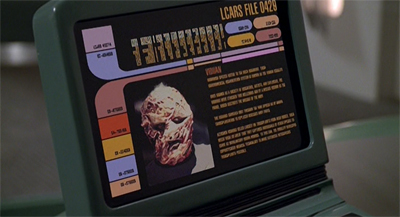
There’s a face to remember.
To be fair, the desire to bring Kes back fits with a broader nostalgia that permeates the final few seasons of Voyager , a renewed engagement with the show’s earlier seasons. This is somewhat surreal, given the turbulence that was taking place behind the scenes during the production of those seasons. More than that, it seems highly unlikely that any fans honestly looked back on the first couple of seasons of Voyager as some long-lost golden age for the franchise. Even the better episodes from that stretch, like Projections or The Thaw , tend to be highly divisive.
Nevertheless, the final seasons of Voyager repeatedly reach back towards the past. Relativity finds Seven of Nine jumping back to the early years of the series, to immediately before the ship’s launch and then forward slightly to the Kazon attacks from around Alliances . Equinox, Part I and Equinox, Part II suggest how the show might have evolved differently from Caretaker . The Voyager Conspiracy found Seven of Nine analysing footage from Caretaker in an attempt to construct a larger meta-arc. Shattered sends Chakotay back to Basics, Part I and Basics, Part II .
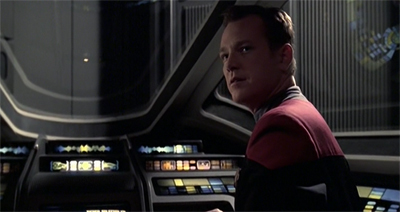
Fresh from the pilot.
Voyager is a television series rooted in nostalgia. After all, it is the story about crew of explorers who find themselves thrown into unknown territory and immediately chart a journey home. Voyager is the Star Trek series that marks the boundary of the final frontier, defining a point at which the franchise begins to double back on itself. Focusing on a journey towards a romanticised and idealised familiar status quo , Voyager paves the way for the more literal nostalgia of Enterprise . Indeed, with its emphasis on space as a wild western and mad science-fiction frontier, Voyager is chasing a more abstract nostalgia.
In hindsight, it is easy to see why Voyager would yearn for the comforts of those early seasons, particularly given several years to insulate the production team from the trauma of the arguments between Jeri Taylor and Michael Piller. In fact, most of the writing staff working on Voyager during its final season had not been present for those early struggles; Rick Berman and Brannon Braga were turning their attention to Enterprise , Joe Menosky was on his way out the door, only Kenneth Biller provided a meaningful connection to those troubled early years.
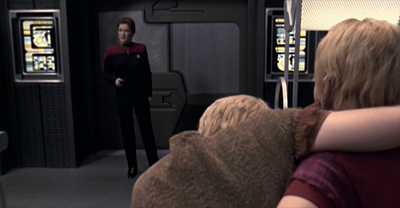
“Trust me, this sort of thing will appear a lot less unusual once you’ve spent a couple of years in the Delta Quadrant.”
In short, the living memory of those troubled years was fading, replaced with a broader sense of longing. When Voyager premiered, it was a triumphant success. It was a television series that carried an entire network upon its shoulders. It was propelled by the momentum established by The Next Generation , and was undoubtedly the greatest success of UPN’s troubled early years. More than that, Voyager premiered at a point when Star Trek was rushing towards its thirtieth anniversary, and when it seemed that the franchise could do no wrong in the eyes of the public.
Those were truly golden days, even if Voyager never appreciated them at the time, even if the production team never leveraged the opportunities afforded them by that success and that goodwill. By the time that Voyager reached its sixth and seventh seasons, Star Trek was in a much more precarious situation. There was only one Star Trek series on television, the last movie starring the Next Generation cast had bombed, and the media seemed to smell blood in the water. It is no surprise that those early seasons seemed to offer comfort and reassurance.
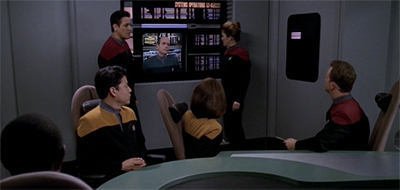
The EMH will be brief.
This might even explain the bizarre characterisation of Kes in the episode, who makes a surprise return in the teaser and proceeds to attack the ship crewed by her former friends. She murders Torres and travels back in time, where she plots to surrender the entire crew to the Vidiians and make her escape back to the Ocampan homeworld. All of this seems incredibly vindictive and bloodthirsty, with the emotional catharsis of revenge as important to Kes as any attempt to liberate her past self from the ship. Kes never considers trying to sneak off the ship and leaving the crew alive.
Fury is decidedly fuzzy on Kes’ motivations for this attack and this vindictiveness. When the Vidiians ask why Kes would betray her crew, she responds, “They’re not my crew. They abandoned me a long time ago.” Janeway receives some elaboration on this point during a confrontation towards the episode’s climax. “I won’t let you hurt her again,” Kes insists. “You took her from Ocampa, her home. She’s a prisoner on this ship.” There is a sense that Kes is embittered by how things have turned out, and is trying to force a reset by destroying Voyager .
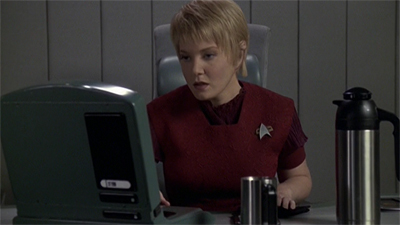
Getting past it all.
There is something very loaded in this, with Kes perhaps speaking for something more than just her character; reflecting a broader anxiety about Voyager and Star Trek . Certainly, her plan to go back in time and destroy Voyager only “fifty six days, seventeen hours” into its journey suggests a type of reset appreciably harder than that in Deadlock , Year of Hell, Part I and Year of Hell, Part II . It isn’t even that Kes is trying to cancel Voyager . She is trying to stop it from existing in the first place.
In some ways, this is a variation on the existential threat posed by Captain Braxton in Relativity , when the time traveler places a ticking time bomb on Voyager during its construction and before the events of Caretaker . There is a clear desire to not only destroy Voyager, but to doom it from the outset. There is something very raw and very primal in all of this. It is worth noting that neither The Next Generation nor Deep Space Nine ever told stories like this about negating their entire existences.
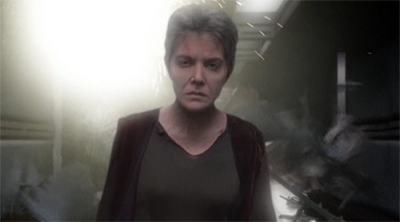
Kes has really blown this reunion.
There is an argument that Voyager was the show that killed the Berman era of Star Trek , even if the franchise limped on through four seasons of Enterprise . In his interview with the Archive of American Television , Berman himself conceded that Voyager might have marked a point of Star Trek over-saturation :
Both Michael and I were excited about creating a show, but we felt that they were pushing it a bit; that there’s just so much you can do, and it all seemed a little quick. Because at that point, The Next Generation was ending, Deep Space Nine was in the middle of its run and a movie was about to be released. And a new television series? But the studio was very emphatic about it.
As Berman and Braga were effectively being strong-armed into creating another new Star Trek series to follow Voyager , it is perhaps revealing that episodes like Relativity and Fury were toying with Voyager ‘s self-negation, imagining a version of Star Trek where Voyager was doomed almost from the outset.
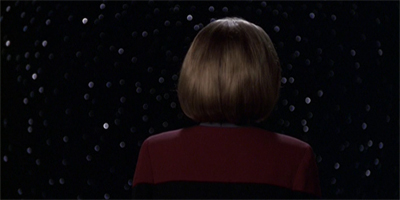
Window of opportunity.
There is another reading of Kes’ rage towards Janeway and the rest of the crew. Fury repeatedly suggests that Kes has become violent and embittered, that the past few years have turned her into something monstrous. Indeed, Fury presents Kes as something akin to a force of nature. The title of the episode alludes the Greek goddesses of vengeance, of sheer and unrelenting anger channeled in a particular direction. In this case, Voyager itself is the target, the ship and crew murdered by somebody who had once loved them dearly.
In some ways, this could be read as a commentary on the increasingly tense relationship that existed between the production team and the fans, particularly in the era of the internet. Modern studies suggest that rage and anger travel faster through social networks than joy and love , but this was obvious even during the early days of the medium . This was particularly true of Star Trek fandom. While Voyager was on the air, groups of fans were scripting vicious “parodies” of the production teams working on the series, mocking Berman and Braga personally and by name .

“A candle for every year did seem impractical.”
There was a palpable tension between the fans and the production team during Voyager and Enterprise . Brannon Braga has acknowledged as much in interviews about his time on the franchise :
I’ll take my share of the blame. I can’t specify to you exactly what that is. I think, always, that I could have done better creatively, but I thought back in the TNG days, too. Also, there just are some real haters out there. There are some people who will go back and says, “Well, look at Braga’s work on TNG. If you really look at it, that sucked, too.” That’s when I feel like I just can’t win. There are just contingents of people who didn’t like the work I did on the shows.
Braga has had a particularly tumultuous relationship with certain sections of fandom, deriding certain strands as “continuity pornographers” and talking about the outsized reactions of “some unpleasant fans.”

Kes is her old self, once again.
As such, Fury reads as something approaching a commentary on a particularly destructive breed of fandom. Kes once loved Voyager , now she wants to destroy Voyager . Indeed, it’s very pointed that the episode ends with a reconciliation rather than defeat, with Janeway killing Kes in the past and then redeeming her in the second time through the loop. “You asked me to help you, to help myself,” Kes recalls. “You wanted me to remember who I was. These years were so filled with confusion and anger. I buried the memory. I’d almost forgotten.”
There is a sense that Voyager is itself trying to reconcile with a fanbase that claims to love Star Trek and seems to vehemently hate Voyager . This was a fan base that took the opportunity of Ronald D. Moore’s departure earlier in the season to attack Voyager , and specifically to malign Brannon Braga . Those links just point to the stuff happening about the line on the major websites, and cannot capture the aggression that was felt on message boards and in comments sections. That fury makes Kes’ rampage seem almost logical and even-handed.

Putting the matter to rest.
Of course, there is something rather uncomfortable in the use of Kes to make this point in Fury , something that feels mean-spirited and ill-advised. Most obviously, there’s no real reason why Kes should have gone psychotic. Even Bryan Fuller struggled to articulate the logic to Cinefantastique :
Actually the reason I got brought in to Voyager in the first place was to come up with a way to kill Kes off. I came up with the story for The Gift. Her whole evolution into a different phase of Ocampan life was my idea. It was kind of fun that we decided to twist that. [It turns out that the transformation] wasn’t all that it was cracked up to be. She evolved, and she just wasn’t ready. It drove her a little crazy.
There is a potentially interesting story their about the Lovecraftian horror of omnipotent awareness and the mind’s incapacity to handle it, which would tap into a rich vein of Star Trek pulp.
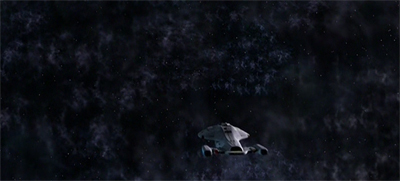
The spaces between.
After all, Star Trek has never been afraid of horror, dating back to The Man Trap , the first episode of the franchise to air. The original series embraced abstract horror storytelling in episodes like What Are Little Girls Made Of? , Operation — Annihilate! , Obsession and The Immunity Syndrome . In fact, Voyager itself has hinted at that sort of storytelling before, with its reliance on weird “anomaly of the week” storytelling in episodes like The Cloud or Bliss . More than any other Berman-era Star Trek spin-off, Voyager was willing to go weird , and Kes losing her mind because of what she had seen would be a nice weird narrative.
Unfortunately, this is not the story that Fury chooses to tell. This is not a story focused on Kes. The Ocampan has very little agency within the confines of the narrative, which makes the return of Jennifer Lien seem pointless. Her older and younger selves never really interact, which would seem to be the emotional crux of an episode like this, the emotional catharsis delivered by a pre-recorded message that. Kes is not presented as a character in Fury , but as a force of nature. This is perhaps best illustrated in the closing shot of the teaser, with Kes marching forward as the ship explodes around her.
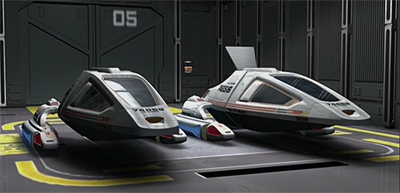
“Look, we even have a spare!”
This is disappointing. Most episodes of Star Trek that bring back a former cast member tend to at least focus on the characterisation of that cast member; Wesley lying to Picard in The First Duty , figuring out something is wrong in The Game , deciding to leave Starfleet in Journey’s End . Even in episodes not nominally about those characters, they tend to get at least some development or closure. Tasha Yar is not the only focal character in Yesterday’s Enterprise , but she arguably gets more character development than she did at any point when Denise Crosby was a series regular.
In contrast, Jennifer Lien’s return gets less fanfare than that of Barclay in Pathfinder . What is Kes’ arc in the episode? She comes back, wants to destroy the ship, then is killed; her younger self records a heart-warming message that ensures that she doesn’t destroy the ship when the loop repeats. There’s never any sense of Kes making any important decision that affects the outcome of the plot. Even the idea to record the message that stops Kes’ rampage comes from Janeway rather than Kes herself. The machinations of the plot are very obvious, and Kes’ characterisation seems very shallow.

Out of time.
The issues with the characterisation in Fury have become something of a punchline for Voyager fans, to the point that some of the licensed tie-in writers have effectively found themselves trying to “fix” it. In Voyages of Imagination , Heather Jarman explains her motivations for writing the String Theory trilogy:
We had a long list of continuity bugaboos and complaints about episodes and characters that we felt were never adequately addressed. For example, why is Janeway such a nutcase at the beginning of season five? Where did B’Elanna’s self-inflicted pain/suffering come from? How did Tom get into Captain Proton? Why does Seven of Nine act like she runs the ship and can tell people what to do? Don’t get me started with the problems with Fury!
Voyager had never been as good at characterisation as Deep Space Nine or even The Next Generation ; Chakotay’s “hobbies of the week” are a great example, with episodes like The Fight , One Small Step or Tsunkatse allowing Chakotay to be interested in whatever the plot needed him to be interested in that week.
However, even allowing for how fickle and flaky the characterisation could be on Voyager , the transformation of Kes from a benign young elf into a vengeful spectre feels like too much of a leap to make in too short a time. These issues are compounded by a rake of other issues that are baked into the premise. How did Kes just happen to find Voyager after travelling more than thirty thousand light years in episodes like Hope and Fear , Night , Timeless , and Dark Frontier, Part I and Dark Frontier, Part II ? Why does Kes even need a ship after The Gift ? Why can’t Kes use her powers to steal her younger self home without a shuttle?
None of these issues would be a big deal if the episode actually worked in any meaningful sense. However, the fact that the actual story doesn’t work just draws attention to the various contrivances at play. This is an underwhelming return for Kes, which seems to be a disappointment given that the audience understands that this will likely mark the last appearance for the character. In some ways, Fury aggressively undercuts the ending afforded the character in The Gift . There were any number of issues with The Gift , but it was a far more satisfying conclusion for Kes’ journey with Voyager than Fury is.
For her part, Jennifer Lien is not particularly impressed with her performance in the episode, although it is not as though the writers gave her the best material :
There were a lot of poor acting choices on my part. I wasn’t really thinking as creatively as I could have with my acting choices. So I’m not really proud of that one, but I was very grateful that they asked me back and that I got to see everyone I’d worked with. But I hadn’t been acting for such a long time and to pick up with a character I hadn’t been with, and to try to have continuity with a character who was so different from what I’d played and to act so out of character – with the other characters, who had developed so much (in her absence) – it was hard. But everyone did their best to work with me.
Indeed, the presentation of Kes in Fury is retroactively tainted further by the real-life issues with which Jennifer Lien has struggled in the years since.
There is an interesting nostalgia that runs through Fury , particularly in the context of its engagement with the early season of Voyager . There is a tangible sense of longing for those early seasons, a conscious desire to recapture some of the spirit of those earlier adventures. Fury features all the markers of an early Voyager episode; it features the Vidiians as antagonists, it rebuilds the airponics bay set for Kes, it even features a number of small (but meaningful) appearances from characters associated with those early years of the show.
Tuvok consults with Samantha Wildman on the bridge about the best way to incapacitate the Vidiians. This marks the character’s final appearance on the show. Wildman had appeared five times during the show’s first two production seasons as the first mother on board the stranded starship, but appeared more irregularly in later years; she had small roles in both Mortal Coil and Once Upon a Time following Kes’ departure. Similarly, Joseph Carey makes a brief appearance in the cargo bay. Carey appeared in four episodes of the first season, and only three episodes of the remaining six.
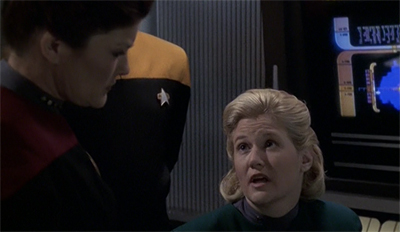
“Thanks for asking. I’m working on a radical approach to parenting. It’s like the opposite of helicopter parenting.”
Fury makes a repeated and concerted effort to remind its audience how much has changed in the intervening years. However, it is telling that those changes are often just shifts in how the show is produced rather than a reflection on how the characters have evolved. There is a notable shift when Kes jumps back in time to the first season, but that shift is often reflected in production and scripting details like Janeway’s hairstyle and desk, the references to the “neural gel packs” that were of such interest to the writers in the first season and so little after that, or the presence of long-absent recurring players.
Very few of these touches represent any real change within the world of Voyager . There is absolutely no reason why Samantha Wildman and Joe Carey could guest star in Fury , but not in The Haunting of Deck Twelve , outside of the fact that they have – through lack of focus – become physical representations of the show’s history. None of the changes between the first and sixth seasons suggest meaningful character growth or development. The EMH still hasn’t picked a name, Paris still feels more at home on Voyager than he would on Earth, Tuvok’s psychic abilities are still a handy narrative crutch.
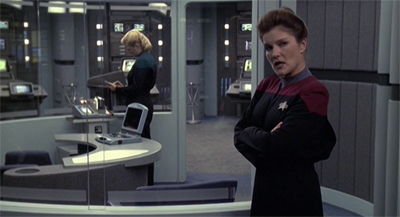
Pregnant with foreshadowing.
This only serves to illustrate how Voyager is a television series frozen in time with little sense of material progress. There would be a marked difference where characters from the penultimate seasons of The Next Generation and Deep Space Nine to encounter earlier versions of themselves. (The same can even be argued of Enterprise , due to the fundamental changes made to the series in its penultimate season.) Picard, Riker, Data, Sisko, Kira, Bashir, Odo, Quark; these characters all change over the run of their shows, growing and evolving. There is no tangible difference between the iterations of Janeway in Fury .
At the same time, there is a sense of revisionism that runs through the portrayal of the early first season in Fury , as if the production team are not just revisiting the early season, but are instead rewriting it. This is how memory works, after all. The very act of remembering changes the memory . When Kes visits the past in Fury , removed by more than half a decade, the past has been subtly changed. There is a sense that the writers are remembering the first season as they would want to remember it, rather than remembering it as it was.
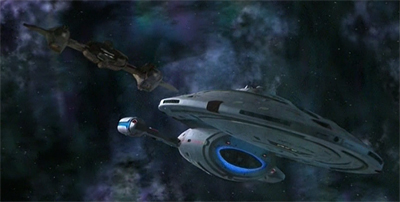
The Vidiians’ organs of government had all but fallen apart by this point in time.
This is perhaps most obvious in the decision to cast the Vidiians as the primary antagonists of the early years, completely marginalising the ill-judged and misbegotten Kazon. This makes a great deal of sense. The Vidiians were a much more interesting opponent than the Kazon, but were also relatively under-exposed. Casting the Vidiians as the antagonists of Fury seems like another tacit acknowledgement from the Voyager production team that the Kazon didn’t work, much like Seven’s dismissal of them as unworthy of assimilation in Mortal Coil .
While Voyager could not wait to get rid of the Kazon, it seems to feel a certain nostalgia towards the Vidiians. The aliens appeared as an element of Janeway’s hallucinations in Coda , received a happy ending to their story through exposition in Think Tank , and were cited among the ship’s most brutal opponents in Good Shepherd . In fact, a character who might be a healthy Vidiian (or simply a recycling of the same prosthetics) even appears in Critical Care during the seventh season. There is a sense watching the later seasons of Voyager that the show knows that it bet on the wrong horses with the Kazon.

“You know, we never really talk about the Kazon this much.”
Fury even makes a point of articulating the cultural anxieties underpinning the Vidiians in a way never explicitly stated in early episodes like Phage or Faces . “Remember the old story?” Janeway asks Chakotay. “Man goes to Risa, where he meets a beautiful woman who invites him over for an evening of passion?” Chakotay finishes the tale, “He wakes up in the morning, feeling wonderful, until he discovers he’s missing a kidney.” Janeway continues, “Every cadet about to go on his first shore leave hears that cautionary tale. Doesn’t seem so outrageous anymore, does it?”
Even in an episode that effectively uses the Vidiians as the muscle behind Kes’ vindictive plans to destroy the ship, Fury makes a point to humanise the Vidiians. “The Vidiians are more than just your garden variety monsters,” Chakotay muses. “I’ve been studying their culture. They were a lot like us before the Phage.” Janeway responds, “Do I detect a note of sympathy?” Chakotay concedes, “Makes you wonder what we’d do under the same circumstances.” Of course, this is all abstract. Fury never bothers to humanise the Vidiians. It never even bothers to name the officer played by Vaughn Armstrong. Still, this is a nice gesture.
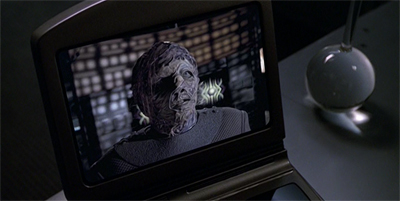
“I mean, I have a name. And hobbies. I’m not just a convenient one-dimensional antagonist. I have dreams!”
However, there are other more subtle examples of revisionism at play in Fury . Perhaps the most obvious is in the way that the episode portrays the relationship between Neelix and Kes. As portrayed in episodes like Phage , Twisted and Parturition , the relationship between Neelix and Kes was one of the most toxic things on television. Neelix was temperamental, jealous and paranoid. Although the show spent very little time with the two characters alone together, the dynamic seemed almost abusive. This aspect of the relationship became even creepier when Kes’ age and relative inexperience were factored into the equation.
Fury brushes aside that characterisation, instead presenting Neelix as a genuinely decent human being who respects his partner’s boundaries and would certainly never dream of intruding into her personal space. When Neelix sees that Kes is having a bad day and wants to be left alone, he respects that. He makes her dinner, but allows her to eat it alone if she wants some space. “Hello, Sweetie,” his message states. “I took the liberty of preparing one of your favourite meals. It’s under replicator programme Neelix One. Call me if you’d like some company. Miss you.” Aw. How sweet. How unlike first season Neelix.
However, this element of revision runs a lot deeper than just the Vidiians and Neelix. The episode plays as something of a time loop; future! Kes travels back in time, Janeway kills future! Kes, past! Kes records a message for herself so that the next time future! Kes attacks she does not go back in time. This plot has all the usual logical headaches involving time travel. After all, if future! Kes doesn’t go back in time, how can past! Kes possibly know to record the message. However, those plotting issues are easily brushed aside with an understanding that time travel is a flexible concept in the Star Trek universe.
The bigger reveal is that Kes traveling back in time in Fury essentially rewrites the history of Voyager . This means that Janeway, Tuvok and Kes had a very rough understanding of how the future would unfold based on what they had witnessed. This knowledge obviously has profound consequences. Just within Fury , it allows Janeway to redeem the wayward Kes using a well-timed message from her younger self. However, it has much more profound implications outside the narrative of this individual episode. In effect, Fury represents a soft reboot of Voyager , a complete rewrite of the show’s earlier seasons.

Holo promises.
The implications are massive. If Tuvok and Janeway know what Kes will become, it fundamentally changes their relationship to her. It is impossible to imagine, for example, Cold Fire unfolding in the exact same manner if Tuvok is aware of what Kes will become when she taps into the full extent of her powers. Similarly, it’s difficult to imagine Kes’ response to having her body hijacked in Warlord or to the temptation to leave in Darkling , once she knows what her future self will become. Indeed, how would The Gift work, if three of the major players in the episode know that Kes will effectively become a monster?
These are just the smaller examples that directly involve Kes. If Janeway and Tuvok know that Kes travels back from the future to try and destroy the ship, then she knows that the ship has a future until at least this point. This means that Janeway must rarely believe that her ship and crew are in tangible danger, because the future must still be ahead of them. How is Janeway supposed to take the Kazon hijacking seriously in Basics, Part I or Basics, Part II ? More than that, what happens in cases where the ship is destroyed but the timeline is reset, like Year of Hell, Part I and Year of Hell, Part II ?
This is obviously one of those “it’s best not to think about” sort of things, but Fury effectively rewrites the entire history of Voyager , such that only a handful of very early episodes could actually conform to what the audience had watched on screen. It is a fascinating example of how loose the continuity was on Voyager , that the writers could essentially rewrite one-hundred-and-forty episodes of television. In its own way, it is as big a reboot as anything that JJ Abrams did with Star Trek , however the implications of this reset are largely ignored in discussions of the franchise.
There is something wry and ironic in all of this, in the manner in which Fury was quietly and so subtly negates so much of the history of Voyager , particularly the earlier seasons. It is a more subtle and less aggressive act of negation than those initially planned by time travelers like Captain Braxton or Kes, but it is no less profound. The characters that the audience encounters at the end of Fury are not the characters that the audience has been watching for six years, they are as alien as the doppelgangers featured in episodes like Living Witness or Course: Oblivion .
There is something very revealing in all of this, suggesting that perhaps the anger and frustration that drives Fury is directed inwards.
Share this:
Filed under: Voyager | Tagged: Anger , change , continuity , fear , hatred , history , jennifer lien , kes , neelix , reset , retcon , retroactive continuity , revenge , rewrite , star trek: voyager , time travel , vidiians , vindictive , voyager |
7 Responses
It’s reminds me of hollow man. Although the story is different and at some places I felt I m watching something similar.
There’s probably something to that, the use of great power for personal vindictiveness.
Great review. The rewriting of history and the break with continuity already starts in the teaser with Tuvok now apparently below the age of 100. How could he possibly have served on the Excelsior in Flashback then?
Kes’ sudden appearance reminded me a lot of Braxton, even down to the fact that she uses his cockpit set. But what happened to Lien’s voice in those two years after her departure from the show? It does not even sound similar to the former Kes. I liked her barely disguised disgust for Neelix, though Neelix seems a lot less invasive regarding his “sweetie” than in the first seasons. The show might have made sense as a revenge story against her treatment by Neelix… Then again, maybe not.
Given Fuller’s affinity for death and horror around the dead it seems logical for him to write this show. But why so many glaring plot holes? Why did Chakotay not do research on who transmitted the shield frequency to the Vidiians? Why are there holoemitters in engineering all of a sudden? I could go on…
But still, in the end the story’s center was quite moving. I think there is a lot of truth in it, that we loose ourselves in the quagmire and confusion of our lives and the years passing, until one day we remember who we once were.
But if Kes were to avenge herself on Neelix, the show would have to acknowledge that Neelix was the worst. Which doesn’t seem like a concession that the show would ever allow itself to make.
Well, Neelix left the show as well prior to its ending… 😉 I never know what to make of him. On the one hand he brought some more color to the show, on the other hand he was a naive and boring rip-off of Quark. Again: Lost potential… Ethan Philipps is actually not bad.
Philips is actually really good. And he tends to do remarkably well when he’s given strong material – particularly episodes like Mortal Coil , but even in the subplot in Someone to Watch Over Me . Indeed, one of my bigger surprises of the past few years has been watching Voyager actors pop up in Coen Brothers films – Robert Picardo in Hail, Caesar! and Philips in Inside Llewelyn Davies .
This episode is loathed by the fans for a reason. It does seem like the writers kind of defecated on the character of Kes, essentially justifying her departure. Now it seems a rather good idea to remove of potential unstable psychopath from the crew and replace her with Seven. Jennifer Lien has been off-screen long enough that we can see she is a bit less slender, which adds to a sense of disconnect. It all plays out very cynically and like a from of self-harm…like Voyager is sabotaging its own internal cohesion.
You write: “This is obviously one of those “it’s best not to think about” sort of things, but Fury effectively rewrites the entire history of Voyager, such that only a handful of very early episodes could actually conform to what the audience had watched on screen.”
Absolutely. There are so many continuity errors, plot holes, and logical inconsistencies (many of which you note in your review), that everything sort of just falls apart in scene after scene of alienated action.
The creepy connections to Lien’s mental health and other issues outside and after Voyager make this episode feel very dark in a whole different way. Berman and Braga have a reputation for having a cruel or abusive streak, and something about Fury seems to feel like we as the audience are getting a taste/glimpse of the work culture that existed at Voyager.
TNG had calm, warm, Ten-Forward and a philosophical briefing room. DS9 had Quark’s/Vic’s and family lives in private quarters/apartments. Voyager has iterative holodeck realities that try to kill the crew or escape the show, and Borg alcoves with new characters hiding from the rest of the ship in a sort of show-within-a-show.
Leave a comment Cancel reply
This site uses Akismet to reduce spam. Learn how your comment data is processed .
Recent Posts
- 371. Poor Things (#246)
- 370. Dune: Part Two (#12)
- 369. Memento (#57)
- 368. Monty Python and the Holy Grail (#154)
- 367. Star Trek: Generations (#—)
Recently tweeted…
- "I Simply Am Not There": The Existential Horror of Eighties Excess in "American Psycho"...
- "... Because That's What Heroes Do": The Curious Definition of Heroism and the Politics of Power in "Infinity War" and "Endgame"...
- Star Trek: The Original Series (Reviews)
- Star Trek: Voyager (Reviews)
Available at…

Blogs Well Worth Your Time
- 1001 Must See Films
- Andrew at the Movies
- Anomalous Material
- Cut the Crap Movie Reviews
- Encore Entertainment
- Fandango Groovers
- FlixChatter
- Four of Them
- It Rains… You get Wet…
- Jameson Cult Film Blog
- Jar Watches Films
- Let's Go To The Movies
- M. Carter at the Movies
- Marshall and the Movies
- Movie News First
- Musings from a Man Lost in La Mancha
- Never Mind Pop Film
- Paragraph Film Reviews
- Roger Ebert's Journal
- Ross v. Ross
- Scannain.com
- Screenwriter (Donald Clarke, Irish Times)
- Strange Culture
- The Film Cynics
- The Pompous Film Snob
- The Projection Booth
- Things That Don't Suck
- Too Busy Thinking About My Comics
- Undy a Hundy
Film Nerd Resources
- CinemaBlend (News)
- Internet Movie Database
- Rope of Silicon
- The Guardian Film Blog
- James Berardinelli
- Roger Ebert
Email Subscription
Enter your email address to follow this blog and receive notifications of new posts by email.
Email Address:
Sign me up!
Blog at WordPress.com. WP Designer.
- Already have a WordPress.com account? Log in now.
- Subscribe Subscribed
- Copy shortlink
- Report this content
- View post in Reader
- Manage subscriptions
- Collapse this bar
Addicted to Star Trek
Episode reviews and essays on almost anything related to Star Trek can be found in this blog.
Friday, November 23, 2018
Episode review - fury (voyager, season 6).
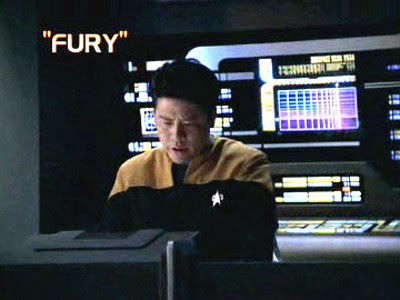
No comments:
Post a comment.

Fury (episode)
- View history
- 1.2 Act One
- 1.3 Act Two
- 1.4 Act Three
- 1.5 Act Four
- 1.6 Act Five
- 2 Memorable quotes
- 3.1 Production
- 3.2 Continuity
- 3.3 Reception
- 3.4 Apocrypha
- 3.5 Production timeline
- 3.6 Video and DVD releases
- 4.1 Starring
- 4.2 Also starring
- 4.3 Also Starring
- 4.4 Guest Stars
- 4.5 Co-Stars
- 4.6 Uncredited Co-Stars
- 4.7 Stunt Double
- 4.8 Stand-ins
- 4.9 References
- 4.10 External links
Summary [ ]

Janeway presents Tuvok a birthday cake
In her ready room , Janeway is grilling Tuvok about a secret he has been keeping. She walks over to the replicator and produces a birthday cake as it turns out to be Tuvok's birthday. Tuvok reluctantly blows out the candle on the cake, claiming it was a " fire hazard ". Commander Chakotay calls Janeway to the bridge . The USS Voyager has received a distress call from a small ship . Sensors reveal the ship has one Ocampan lifeform on board. It is an aged Kes , now around six or seven years old and appearing frail and weak, asking for permission to beam aboard. When Captain Janeway questions her motives, Kes cuts the com channel. Immediately after, her ship is on a collision course with Voyager and just before it is destroyed, Kes manages to transport herself on board.
Act One [ ]
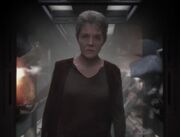
Kes makes her way to engineering
Furiously, she makes her way to engineering , giving off high levels of neurogenic energy that destroy the sections she is walking through. She does not respond to any hails from the captain and even force fields cannot hold her back.
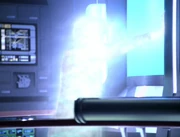
Kes vanishes in the present...
All attempts by Ayala and a security guard to stop her fail and she finally reaches engineering , making her way to the warp core . While she is holding on to the core, she kills B'Elanna Torres with an energy pulse emitted from it. Holding on ever stronger to the warp core, she lights up and disappears. She somehow uses the warp core to travel back in time to 2371 , 56 days and 17 hours after Voyager had become trapped in the Delta Quadrant .
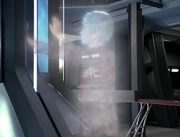
...and re-appears in the past
In 2371, there are now two Keses: the one that belongs to 2371 and the one that has traveled back in time to 2371. Materializing right next to the warp core, she transforms herself into a duplicate of the young Kes. The Torres of 2371 asks Kes if she would like to stay and observe a warp core assembly , but she tells the chief engineer she is needed in sickbay . Upon arriving there, Kes starts fiddling around with some of The Doctor 's medical instruments. The Doctor is annoying her with his questions about what name to pick for himself. Barely listening to him, she picks up a hypospray and rushes out of sickbay.
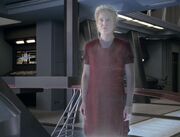
Kes takes on her former appearance
In the airponics bay , the real Kes who belongs to the timeline, is attacked from behind by the "old" Kes, sedated and hidden, so that there are not two Keses walking around the ship.
Act Two [ ]
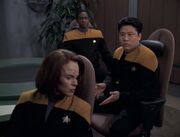
" The Delta Flyer . "
In the mess hall , Tom Paris and Neelix are chatting about some unique names he could use for a cheeseburger he has made, when Kes walks in and asks Neelix for some coffee that she wants to bring for the captain. She is a bit grumpy and distanced, unable to laugh at Neelix's jokes as she used to. She grabs a canister with coffee and goes to the captain's ready room. Janeway and Chakotay are there discussing the Vidiians , with the captain and first officer discussing the plight of the imperiled species and the lengths they go to to harvest organs. Chakotay wonders what Humans would do if they were faced with similar circumstances. Kes arrives shortly after and she spills some coffee on the captain's desk, supposedly by accident, and when the captain is called to the bridge, Kes accesses Janeway's computer terminal. When Kes leaves the ready room, Tuvok, who is standing on the bridge at the science station with Janeway and Ensign Wildman , looks at her from afar as if he sensed something.
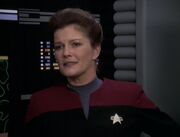
" The Delta what? "
Later, during a staff meeting in Voyager 's briefing room which is all about finding a way to evade the Vidiians and navigate the ship through a region of space densely packed with subspace vacuoles , Tuvok suggests taking the Delta Flyer with its advanced sensors to navigate through the region. This comes as a big surprise to everyone, because they have never heard of a Delta Flyer . Tuvok apologizes, believing that he must have been thinking of another starship .
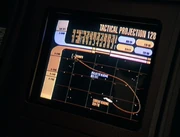
" Planning on going somewhere? "
Paris finds Kes sitting in a shuttle programming a trajectory to Ocampa and asks her if she is homesick . She claims she's not. She's "studying" the helm configuration and asks Paris to teach her how to fly. He agrees to give her some tutorials in the holodeck in an old Class 1 shuttle .
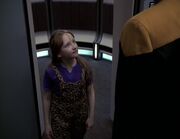
" Identify yourself! " " It's me Tuvok, Naomi Wildman. "

While entering a turbolift Tuvok sees Naomi Wildman . He follows the hallucination to Cargo Bay 2 where he sees the alcoves with all the rescued former Borg, Azan , Rebi , and Seven of Nine , regenerating. Then he snaps back to reality when Lieutenant Carey , working at a console, asks him if he is all right.
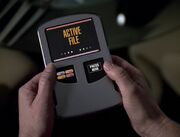
Kes finds a message from Neelix
Kes walks into her quarters to find that Neelix has prepared one of her favorite meals for her, leaving her a message that says how much he misses her. Suddenly, she becomes irrationally angry and furious, throwing everything off the table and yelling at the computer to turn off the music. She then asks it to open an encrypted channel and direct the signal to the Vidiians whom she informs about Captain Janeway's plan to evade their vessels. She offers to send them tactical data on shields , weapons and anything else they need to take Voyager . In return, she asks for safe passage back to Ocampa for herself and one other person. When asked by the Vidiian why she is abandoning her crew, she coldly states that they are not her crew, for they abandoned her long ago.
Act Three [ ]
Kes is back in airponics checking up on her younger self whom she apparently has hidden in one of the drawers. After finding everything okay she heads over to a computer console to ascertain Voyager 's tactical information where she bypasses the command authorization by using her powers.
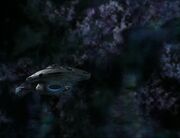
" It does feel like we're sneaking through a graveyard at midnight. "
In the meantime, Tuvok discusses his hallucinations with the captain in her quarters . He informs her of having run into a half- Human , half- Ktarian girl named Naomi Wildman in the turbolift and also of his encounter with a woman and several children with cybernetic implants. He cannot explain what is happening to him. Even though he has had hallucinations before, it has always been in the context of deep meditation . However, these are specific, evoking a sense of anticipation. He is concerned because Vulcans generally do not have premonitions. Janeway instructs the computer to run a continuous scan around Tuvok so they can monitor what is happening to him next time he has another one of his visions.
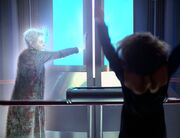
The final premonition
Then Chakotay calls them to the bridge to inform them they have reached the subspace vacuoles. Voyager is programmed to fly at warp and make course corrections according to previously made scans of this region. This is going to take 3 hours 12 minutes and 11 seconds according to Tom Paris with 216 course changes. After the first course correction the captain leaves for sickbay to ask about Ensign Wildman . Then Tuvok has another hallucination. This time it is a sensor reading of a vessel on a collision course, which no one else is seeing. Tuvok asks to be relieved of duty.
The Doctor, albeit reluctantly because of doctor-patient confidentiality, confirms Ensign Wildman's pregnancy which is producing a half-Ktarian female offspring, Janeway realizes that everything Tuvok said is true and that there is something very strange going on.
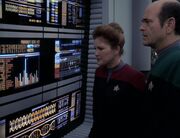
" Tachyons. "
Tuvok's hallucinations become stronger and more frequent until he finally breaks down in engineering and goes into synaptic shock. Examining the proximity scan of Tuvok at the time where he broke down in engineering, Janeway discovers a surge in tachyon particles, indicating temporal distortions and thus probably time travel . While nervous about these findings and researching the occurrence of tachyon particles elsewhere on the ship, Voyager suddenly finds itself under attack by the Vidiians.
Act Four [ ]

Voyager breaks free
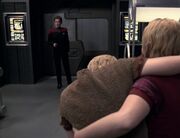
" Now one of you doesn't belong here, and I'm guessing it's you. "
The Vidiians keep matching Voyager 's shield frequencies. Then the Vidiian ship attaches itself to Voyager 's hull , trying to access the ship directly. Janeway asks for the neural agent The Doctor has been developing and asks him to release it in the sections where the Vidiians have cut a hole through the hull, but much to their horror they find that environmental controls are not responding; they have been locked out of that system, all command relays have been fused and the Vidiians are about to board Voyager . Janeway realizes that the Vidiians knew where to find them, along with their shield frequencies and which systems to target.
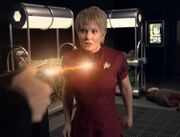
Janeway, out of options, is forced to kill Kes
An electromagnetic fluctuation indicative of a transmission is detected in the airponics bay. Bioreadings pick up two Keses. Janeway makes her way down there, where Kes is about to unsuccessfully initiate a site-to-site transport. Janeway confronts her in the airponics bay. When asked why she is helping the Vidiians, Kes tells her that she is from a future she is hoping to change, and uses her telekinetic powers to throw Janeway around the bay and out of her way. She says that she won't let them hurt her again by taking her from Ocampa, her home. She claims to have been a prisoner on this ship, a child who was corrupted by their ideas of exploration and discovery. She tells her that in three years she will leave Voyager in search of higher things because Janeway encouraged her to develop her mental abilities; something she was not ready for. She couldn't control what she found. It scared her, and she felt she had nowhere to go. She thought of returning home to Ocampa, but knew that the people on her home world would be frightened by her mental abilities and not accept her. But they will accept the younger Kes, the one she is holding and wanting to transport over to the Vidiian ship.
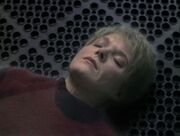
The mask falls off
All attempts by Janeway to make her understand reason fail, and Kes becomes more and more furious until finally Janeway has no choice but to set her phaser to kill Kes. Meanwhile, Chakotay, utilitzing decisive and creative tactics, manages to break Voyager free of the Vidiian ship and drive them off.
Act Five [ ]

Janeway contemplates what is to come
Later, in engineering, Tuvok, who is standing in front of the warp core, says that Kes was standing exactly here during his last premonition, where she appeared older, her face tired. They note that tachyons are concentrated in the warp core and that it was possible that she used the core to travel back in time. If that is true, then she will need it again but unfortunately, they don't know when that will be and yet they have to be ready for it.
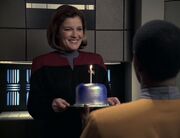
The present arrives again
When young Kes regains consciousness, Captain Janeway tells her in confidence what has happened and that they will need her help to prevent it from happening again.
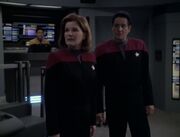
" I'd almost forgotten. "
Five years later, Voyager receives a distress call from a small ship. Sensors reveal the ship has one Ocampan lifeform on board. It is an aged Kes, who appears frail and weak, asking for permission to beam aboard. When she hears that, Janeway, who admits she had almost forgotten the incident, is immediately alerted and knows what to do. She raises shields and goes to red alert and orders the emergency evacuation of deck eleven. Kes' ship is on a collision course with Voyager and just before it crashes, Kes beams herself on board. Furious, she makes her way to engineering, giving off high levels of neurogenic energy that destroy the sections of the corridor she is walking through. She does not respond to any hails and even force fields cannot hold her back. On the bridge, Janeway orders the shutdown of the warp core and signals to Tuvok to be ready and follow her.
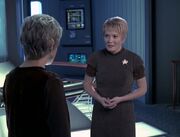
" Try to remember who you were; try to remember me. "
In engineering, Janeway plays the hologram Kes had recorded before leaving Voyager . In that, the holographic recording of Kes reminds her older self that no one forced her to do anything; that she was the one who made the decision to leave Ocampa and also the one who made the decision to leave Voyager . She asks her not to take revenge and just find another way home with the captain's help. She asks her to try and remember who she used to be. Janeway walks in, telling her what will happen if she crosses the timeline again. She offers her to stay with them on Voyager but Kes says that she cannot, for she does not belong there anymore and needs to be with her own people. Suddenly she smiles, saying that she now remembers the holo-recording she made years ago to remind herself of who she is. Janeway asks her whether it really matters which Kes goes home.
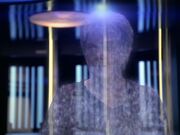
Kes's final farewell
In the transporter room , the captain and Neelix are sending Kes off. Neelix hands her a few snacks of leola root for the journey home and looks at her in reminiscence. When she asks him if he sees anyone he knows with a small smile, as she had changed a lot both inside and out, he replies that he only sees her. After Kes is beamed back to her vessel, Tuvok asks what they should tell the others. Janeway says to simply tell them that a friend got lost and they helped her find her way. With these words Janeway and Tuvok leave the transporter room and Kes' ship sets a course for home.
Memorable quotes [ ]
" We've known each other for how long? " " Approximately twenty years. " " We've served on three starships together. I was present at your daughter's kolinahr . I consider you one of my closest friends. " " And I regard you with the same esteem. " " I've always been honest with you, but you've been keeping something from me. " " I don't know what you mean. " " Don't you? It took exhaustive research, sifting through teraquads of data, separating fact from rumor, but eventually I arrived at the truth. " " Captain? " (Janeway turns to her replicator and replicates a small cake with a lit candle.) " Happy birthday. "
" It was a fire hazard. "
" Lieutenant Torres is dead. Kes has vanished. "
" Identify yourself. " " It's me, Tuvok. Naomi Wildman. "
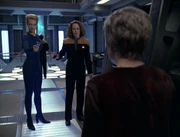
" State your intentions! "
" We'd need a more accurate scan of the region. If we even graze one of those vacuoles... " " We could send a shuttle ahead. " " The Delta Flyer. Its sensors are more advanced. " " The Delta what? " " Forgive me. I must have been thinking of a different ship. "
" One down, 215 to go. "
" What do you remember? " " I was in airponics, and then I felt dizzy, and then I was watching myself. " " Yourself? " " Computer, deactivate EMH. "
" They're trying to lock on us with a tractor beam. " " Reverse thrusters, full power! " " That'll tear the hull apart. " " Then tear it apart! "
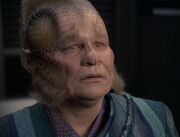
" Only you. "
" What? " " Just looking. " " See anyone you know? " " Only you. "
" Home for me means a penal colony. Out here, I get to fly a state-of-the-art ship and there's no admirals in sight. "
" Remember me? The innocent child you're here to save? You blame Captain Janeway, but the choice was yours. You made the decision to leave Ocampa, and you made the decision to leave Voyager . If you're watching me now, you've come back to take back revenge on the people who cared about you. That's not who you are, and that's not who I am. Don't do this. Find another way home. Captain Janeway will help you if you give her a chance. Try to remember who you were. Try to remember me. "
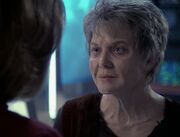
" Does it really matter which Kes goes home? "
" I remember. " " What? What do you remember? " " The holo-recording, I remember making it. You asked me to help you, to help myself. You wanted me to remember who I was. These years were so filled with confusion...and anger. I buried the memory. I'd almost forgotten. " " Does it really matter which Kes goes home? "
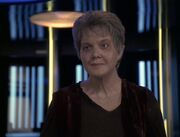
" Captain. "
" Goodbye, Kes. " " Captain. "
" What should we tell the others? " " A friend got lost. We helped her find her way. "
Background information [ ]
Production [ ].
- Prior to the making of this episode, Chakotay actor Robert Beltran said that he "certainly hoped" there would be a forthcoming episode featuring Kes. [1] (X)
- The writing of this episode began with Rick Berman deciding he wanted the character of Kes to return. The story of "Fury" was not yet written, however, when Kes actress Jennifer Lien accepted an invitation, from Berman, to make a return in the episode. As part of persuading Lien to make the proposed comeback, the creative staff " convinced her it was a terrific story, and thus a good reason to bring Kes back, " stated Berman, who was given on-screen credit for having co-written the story, along with Brannon Braga . " [Berman] put it in the writing staff's hands to come up with an idea for her to come back. Brannon spearheaded the story, " explained Bryan Fuller , who co-wrote the installment's script with Michael Taylor . Fuller's involvement in this episode was somewhat ironic, as he had started his work on the series by firstly suggesting the method in which Kes would leave the show, in the fourth season outing " The Gift ". ( Cinefantastique , Vol. 33, No. 5, p. 32)
- The final draft of this episode's script was issued on 21 January 2000 .
- The cockpit of Kes' ship as she enters Voyager is a reuse of the cockpit of the timeship Aeon that Captain Braxton uses in the third season episode " Future's End " and the interior of Kovin's ship in " Retrospect ".
- The success of this episode depended on its visual effects. The outing tasked Director John Bruno and the visual effects crew, operating under Visual Effects Producer Dan Curry , to depict explosions, put numerous versions of Kes on-screen simultaneously, and portray an enemy Vidiian ship. Visual Effects Supervisor Ronald B. Moore enjoyed the collaboration with John Bruno, as the two had worked together before and because Moore respected Bruno's knowledge of effects. Recalled Moore, " We did a lot of greenscreen work and split-screen; it was pretty complex. We didn't get the entire script until after we'd started production. We didn't have quite a chance to plan this as far as we should. " ( Cinefantastique , Vol. 33, No. 5, p. 32) Regarding the extent of the visual effects, Moore noted, " We did stuff beyond what we have done before. " ( Cinefantastique , Vol. 33, No. 5, p. 33)
Continuity [ ]
- No stardate is given for the scenes set in the past, although the computer states that Voyager has been in the Delta Quadrant "fifty six days, seventeen hours". The Vidiians are a known threat, dating the scenes after the events of " Phage " which take place on stardate 48532. The Doctor says he is "considering the name Schweitzer", which he takes in " Heroes and Demons " (the events of which occur over the course of stardate 48693 to 48710), but ultimately decides not to adopt permanently at the end of that episode due to the "painful" association of that name - suggesting that the scenes are dated before 48693. The Doctor first showed an interest in taking a name at the end of " Eye of the Needle ", which occurred on stardate 48579, indicating this occurs after those events. This places the episode somewhere in the middle of the first season.
- Kes last appeared in the fourth-season episode " The Gift ", after being a regular character since the series premiere " Caretaker ".
- This episode marks the final appearances of Kes (Jennifer Lien), Ensign Samantha Wildman ( Nancy Hower ), and the Vidiians on the series.
- Kes' final appearance in this episode also marks the final appearance of any member of the Ocampa species in the series.
- This is the only episode in which any direct, face-to-face interaction occurs between Seven of Nine and Kes, when Seven tells Kes to "State your intentions." However, they were present on the bridge together in " Scorpion, Part II " and Kes helped treat Seven in sickbay in " The Gift ".
- This episode is the third and final episode to include the complete cast of the show from all seasons. The previous two episodes to do this were " Scorpion, Part II " and " The Gift ".
- This episode contains the last mention of Deep Space 9 to air on Star Trek: Voyager . However, it occurs in a scene set in 2371. This makes a line from the earlier episode " Pathfinder " the last time in the series chronology that the station is mentioned on screen.
- In a scene set in 2376, Janeway mentions it isn't long before Tuvok hits "the big three digits", a statement that goes against everything that had been established about Tuvok's age prior to this episode. Most notably, in the third-season episode " Flashback " Tuvok claimed he "was twenty nine years old" at a point in time "approximately eighty years ago", suggesting he was at least 108 at the time.
- This episode establishes the warp manoeuvring maxim " Faster than light, no left or right ". This would seem to be supported in the seventh-season episode " Drive " in which the alien Irina says "warp's fine if you like going fast in a straight line."
- The Doctor states to Janeway that the length of Ensign Wildman's pregnancy should be "nearly doubled" by the genetic contribution of the baby's Ktarian father. As such, this episode finally explains why she didn't give birth until the late second-season episode " Deadlock ", given the moment of conception would have been before Voyager 's arrival in the Delta Quadrant over a year earlier.
- Chakotay says that the Vidiians "were a lot like us before the Phage." In " Phage ", a Vidiian claims that "before the phage began, we were known as educators and explorers, a people whose greatest achievements were artistic."
- In 2371, Tuvok says he's "had hallucinations before, but only while in a state of deep meditation." He would (chronologically) later hallucinate in " Persistence of Vision " as a result of alien influence, and in " Flashback " due to a resurgence of suppressed memories caused by a viral infection.
- The appearance of a holographic Kes in Engineering suggests that holoemitters have been installed there. This was done before in " Persistence of Vision " to allow The Doctor to appear throughout the ship, but malfunctions caused this effort to be abandoned. This episode would suggest that the issue was fixed.
- Tuvok mistakenly has his commander pip in the past. He did not earn this promotion until the fourth season episode " Revulsion ". Although this is technically a continuity error, it is actually consistent as Tuvok was mistakenly shown wearing a commander's pip throughout the first half of season one.
- During the battle with the Vidiians, Kim warns that reversing thrusters at full power could tear the hull apart, and Chakotay responds, " Then tear it apart! " This is similar to an exchange between Lojur and Hikaru Sulu in Star Trek VI: The Undiscovered Country , where the latter orders the former, " Fly her apart, then! " while racing to assist the USS Enterprise -A at Khitomer .
- The Doctor's quest to find a name is referenced in this episode in a scene set in 2371, when he tells Kes of some names he has been considering for himself, one of which, "Schweitzer", he chooses to go by temporarily in " Heroes and Demons ".
- This episode chronologically depicts the first appearance of the Class 2 shuttle , which did not appear in the series until the second-season episode " Threshold ".
- When Paris discovers the future Kes aboard a Class 2 shuttle, she feigns interest in learning to fly a shuttle. This prompts Paris to offer to teach her, saying "I could start you off in the holodeck, in an old class 1". This scene is a 'prequel' to the second-season episode " Parturition ", in which Paris does teach Kes how to pilot a class 1 shuttle in the holodeck.
- This is the only episode in which Azan and Rebi appear but Icheb and Mezoti do not.
- In the new 2376, Janeway tells Kes " three years ago , you traveled back in time." Kes did in fact travel back in time three years ago (along with the whole crew) in the third-season episode " Future's End ", but in this episode, Kes traveled five years back in time, not three, and it's likely Janeway made a mistake.
- The visual effect when Kes attacks Ayala and the other security guard in the corridor, as well as Seven and Torres in engineering, is similar to the effect from " Where No Man Has Gone Before " when Elizabeth Dehner and Gary Mitchell are first exposed to the effects of the galactic barrier. In both cases there is a brief flash of light accompanied by the color palette of the affected characters being inverted.
- Three photon torpedoes are used in this episode, one having previously been used in " Good Shepherd " (although in this episode, the depicted torpedoes are shown to have been used in the past). This brings the total number of torpedoes confirmed to have been used by Voyager over the course of the series to 66, a total which exceeds the supposedly irreplaceable complement of 38 that had been established by Chakotay in the first-season episode " The Cloud ".
- The scenes in the past reflect various character traits established at that time during Season 1, including Captain Janeway's hair bun, Neelix and Kes' romantic relationship, and the rude manner in which the crew treats the Doctor on apart of his being a hologram.
Reception [ ]
- Few people expected that, in this episode, Kes' return would be as radical as it turned it to be. ( Cinefantastique , Vol. 33, No. 5, p. 32)
- Bryan Fuller once commented that, owing to Brannon Braga's involvement in the writing of this episode, its story "came out quite nicely." Fuller also remarked about Kes' evolution as an Ocampan, " It was kind of fun that we decided to twist that. " ( Cinefantastique , Vol. 33, No. 5, p. 32)
- Ronald B. Moore was ecstatic about the footage of Voyager being wrecked by a Vidiian ship, commenting, " I was very, very happy with that. " ( Cinefantastique , Vol. 33, No. 5, p. 33)
- Cinefantastique (Vol. 33, No. 5, p. 38) gave this episode 3 and a half out of 4 stars.
Apocrypha [ ]
- In the novel Star Trek: Voyager - String Theory - Evolution , it is revealed that the Kes that appeared in this episode was technically not Kes, but was actually the result of Kes merging with another Ocampan who was undergoing a complex 'pregnancy' with a Nacene , with the Kes depicted here essentially being a manifestation of the darkness within Kes rather than Kes herself.
Production timeline [ ]
- Final draft script by Bryan Fuller & Michael Taylor: 21 January 2000
- Additional revisions: 25 January 2000 , 27 January 2000 , 28 January 2000
- 12 January 2000 : Beat sheet of major story elements delivered to Moore.
- 13 January 2000 : First draft script delivered to Moore.
- 14 January 2000 : Episode pre-production meeting held.
- 21 January 2000 : Episode pre-production meeting held. Optical meeting held. Final draft of script delivered.
- 24 January 2000 : First (half) day of production.
- 26 January 2000 : Episode director John Bruno works on stage.
- 27 January 2000 : Optical meeting at 6:45 a.m. on the Voyager mess hall set. Moore submits revised episode budget.
- 28 January 2000 : Visual effects shoots on set. Braga and Moore on set.
- 31 January 2000 : One visual effect is shot on set.
- 2 February 2000 : Last full day of first unit, no visual effects work.
- Original airdate: 3 May 2000
Video and DVD releases [ ]
- UK VHS release (two-episode tapes, Paramount Home Entertainment ): Volume 6.12, 27 December 2000
- As part of the VOY Season 6 DVD collection
Links and references [ ]
Starring [ ].
- Kate Mulgrew as Captain Kathryn Janeway
Also starring [ ]
- Robert Beltran as Chakotay
- Roxann Dawson as B'Elanna Torres
- Robert Duncan McNeill as Tom Paris
- Ethan Phillips as Neelix
- Robert Picardo as The Doctor
- Tim Russ as Tuvok
- Jeri Ryan as Seven of Nine
- Garrett Wang as Harry Kim

Also Starring [ ]
- Jennifer Lien as Kes
Guest Stars [ ]
- Nancy Hower as Samantha Wildman
- Scarlett Pomers as Naomi Wildman
- Vaughn Armstrong as a Vidiian captain
- Josh Clark as Joe Carey
Co-Stars [ ]
- Kurt Wetherill as Azan
- Cody Wetherill as Rebi
- Tarik Ergin as Security Guard
- Majel Barrett as Computer Voice
Uncredited Co-Stars [ ]
- Andrew English as Voyager operations officer
- Caroline Gibson as Voyager operations officer
- Peter Harmyk as Thompson
- Grace Harrell as Voyager operations officer
- Tina Kotrich as Voyager operations officer
- Joyce Lasley as Lydia Anderson
- Unknown performers as two Vidiian boarding party members
Stunt Double [ ]
- Unknown stunt performer as stunt double for Kate Mulgrew
Stand-ins [ ]
- Amy Kate Connolly – photo double for Jennifer Lien
- Brita Nowak – stand-in for Jeri Ryan
References [ ]
acceleration ; airponics bay ; annual physical ; antigraviton ; apple ; Asil ; Badlands ; battle stations ; birthday ; birthday cake ; birthday candle ; Borg ; cancer ; Cardassians ; cautionary tale ; Class 1 shuttle ( unnamed ); Class 2 shuttle ( two unnamed ); coffee ; collision course ; command authorization ; coordinates ; cortical stimulator ; day ; Deep Space 9 ; Delta Flyer ; dizziness ; doctor-patient confidentiality ; " Double Talaxian with cheese "; Earth ; environmental systems ( environmental controls ); evasive maneuvers ; fire hazard ; frown ; Galor -class ( unnamed ); " garden variety "; gestation ; graveyard ; " Greasy Neelix "; Greskrendtregk ; hallucination ; herbs ; holodeck ; holo-recording ; home ; homesick ; immune system ; impulse drives ; inertial damper ; intruder alert ; Jarvik, Robert ; Kes' starship ; kidney ; kilometer ; Ko, Pyong ; kolinahr ; Ktarian ; lectrazine ; leola root ; logic ; Maquis ; meditation ; mental ability ; menu ; meter ; milligram ; millijoule ; milliliter ; Mulchaey ; name ; Neelix 1 ; neural agent ; neural gel pack ; neuro-stabilizer ; neurogenic energy ; New Zealand Penal Settlement ; Ocampa ; Ocampan ; organ bank ; Oshionian Prime ; parsec ; Paris, Owen ; Pasteur, Louis ; penal colony ; phage ; photon torpedo ; polarity ; premonition ; replicator ; Risa ; Risa kidney donor and thief ; safe passage ; Schweitzer, Albert ; shields ; shield frequency ; shore leave ; scouting mission ; site-to-site transport ; smile ; structural integrity ; subspace vacuole ; synaptic shock ; tachyon ; tactical alert ; tactical database ; telepathic ability ; temporal distortion ; teraquad ; time travel ; tractor beam ; Vidiian ; Vidiian ship (2371-2372) ; vote of confidence ; Vulcans ; warp core ; warp core assembly ; warp energy ;
External links [ ]
- "Fury" at StarTrek.com
- " Fury " at Memory Beta , the wiki for licensed Star Trek works
- " Fury " at Wikipedia
- 2 USS Enterprise (NCC-1701-G)
- 3 Star Trek: The Next Generation
- Show Spoilers
- Night Vision
- Sticky Header
- Highlight Links

Follow TV Tropes
http://tvtropes.org/pmwiki/pmwiki.php/Recap/StarTrekVoyagerS6E23Fury
Recap / Star Trek Voyager S 6 E 23 Fury
Edit locked.

This episode provides examples of:
- Affectionate Gesture to the Head : Evil Kes strokes the hair of her unconscious younger self.
- Ageless Birthday Episode : Tuvok's exact age isn't stated. Janeway's remark about him approaching "the big three digits" suggests he's somewhere from 95 to 99.
- Asteroid Thicket : Well, a Subspace Vacuole Thicket, but it serves the same purpose. Voyager will have to slow down to safely navigate it, making it a great spot for a Vidiian ambush.
- Beware the Nice Ones : Kes, as her vengeful older self causes panels in the corridor to explode at her mere presence.
- Biological Weapons Solve Everything : Samantha and the Doctor have developed a neural agent to incapacitate a Vidiian Boarding Party , albeit a nonlethal one.
- Blatant Lies : Tuvok blows out the candle on his cake because it's a fire hazard.
- Boarding Party : The Vidiians board Voyager. All two of them.
- Kes rams her shuttle into Voyager, teleporting on board just before impact.
- The Vidiian cruiser latches onto Voyager with grappling cables that cut through the hull.
- Butt-Monkey : The Doctor is complaining that if only he had a name, people would treat him with more respect. He turns to find that Kes has slipped out of the room while he's talking.
- While discussing an Offscreen Moment of Awesome involving Diverting Power during an attack, Janeway agrees with Chakotay that B'Elanna was a good choice for Chief Engineer. Chakotay pushed for her promotion in "Parallax".
- The Vidiians, introduced in "The Phage".
- The Doctor's search for a name, which he asked Kes to help him choose in "Eye of the Needle".
- Samantha Wildman is conducting an analysis of the Vidiian biology. She hasn't told Janeway about her pregnancy yet, which happens in "Elogium" in Season 2.
- B'Elanna mentions the Maquis using the Badlands to ambush Cardassian cruisers ("Caretaker").
- Past Janeway keeps shutting off the Doctor in mid-sentence.
- Joe Carey does his usual flashback cameo. After all, it's not like he's still alive in the future... is he?
- Contrived Clumsiness : While pouring Janeway coffee, Kes 'accidentally' spills some on her desk so she has an excuse to linger in the Ready Room to clean up the mess.
- Janeway states at the beginning of this episode (prior to the time travel shenanigans) that Tuvok's age has yet to reach 100. This goes against everything that had been established about Tuvok's age, approximately 113, prior to this.
- Tuvok mistakenly has his commander pip in the past, but he wasn't promoted to that rank until "Revulsion" in Season 4. Ironically this is actually consistent as Tuvok was mistakenly shown wearing a commander's pip throughout the first half of Season One.
- Death Glare : It's not often that Janeway encounters someone whose glare is more lethal than her own. Evil Kes is able to blast people aside with a look.
- Death is Cheap : Two security officers, B'Elanna Torres and Older Kes die as a result of her Roaring Rampage of Revenge . However memories of these events enable Janeway and Tuvok to prevent them in the future.
- Desk Sweep of Rage : Seeing Neelix has left flowers and Your Favourite meal in her quarters, Kes smashes the recorded message he left and sweeps the flowers off the table.
- Don't Make Me Destroy You : Janeway: It's set to kill, Kes...
- Face–Heel Turn : Up until the point that her older self sees the Note to Self when events began to repeat themselves.
- The Fog of Ages : Older Kes has forgotten that she made the recording three years ago, almost half her lifetime.
- Hallucinations : Season One Tuvok finds himself seeing Naomi Wildman, Seven of Nine and the Borg children. Later he starts Hearing Voices about the events before Evil Kes time-jumped.
- Innocent Flower Girl : Kes' younger innocent self is tending her flowers in the Airponics Bay when older Kes hyposprays her.
- Lured into a Trap : Vidiian spaceships are appearing on their sensors just long enough to make Voyager change course from time to time. The crew realise they're being herded into a region of subspace vacuoles that make maneuvering at warp difficult .
- The Main Characters Do Everything : Janeway leaves the bridge in the middle of a battle to confront Kes. At least her absence gives Chakotay a chance to look badass.
- Mandatory Line : As the plot largely takes place during the time where Seven wasn't part of the crew yet, her main task this episode is getting mind-blasted by Kes in Engineering.
- My Significance Sense Is Tingling : When Tuvok catches sight of Future Kes posing as her younger self, his expression shows he realises something is wrong. Then he starts recalling events that haven't happened yet.
- Mythology Gag : It wouldn't be the first time that a main character has been killed by a recurring character who has gained lethal powers and gone off the deep end , although in this case, Death is Cheap thanks to the Reset Button .
- Newspaper Dating : As they're IN SPACE! , Kes just asks the ship's computer. Kes: Computer, how long has Voyager been in the Delta Quadrant? Computer: 56 days, 17 hours.
- No-Sell : A Forcefield Door is thrown across the corridor in Kes' path, but she just steps through it. She also isn't incapacitated by a stun blast, so Janeway has to increase the setting enough to kill her.
- Not Hyperbole : When Kim warns that Voyager's hull could be torn apart he's not joking, as a large section of hull is ripped open to space when the last grapple tears loose.
- Note to Self : Younger Kes leaves one for her older self in the form of a hologram that activates years later to remind herself what she chose to do by being part of Voyager 's crew.
- Not so Dire : What Dark Secret is Tuvok hiding from his captain? Janeway: ( Death Glare ) I've always been honest with you, but you've been keeping something from me. Tuvok: I don't know what you mean. Janeway: Don't you? It took exhaustive research, sifting through teraquads of data, separating fact from rumor, but eventually I arrived at the truth. Tuvok: Captain? (Janeway turns to her replicator and replicates a small cake with a lit candle.) Janeway (with a huge smile): Happy birthday.
- Not So Stoic : Evil Kes can't help smiling when meeting Neelix again. She also looks shocked after trying to dispose of her former mentor Tuvok.
- Person of Mass Destruction : What Kes became upon her return.
- Red Shirt : Kes psychic-blasts two security personnel along with a large part of the corridor when she first arrives. Averted later on, when the cycle repeats, and Janeway orders the sections of the ship in Kes' path to be evacuated to prevent casualties.
- Reverse Polarity : Chakotay uses this and some Techno Babble to break Voyager free.
- Ridiculously Difficult Route : Does Voyager take the long way around the region of dangerous subspace vacuoles that constantly shift their position , in which Vidiian organ hunters are waiting in ambush? Of course not!
- Sacrificial Lion : Kes kills B'Elanna before time-jumping, just to put across that she really has turned evil.
- The Shuttlecraft Came Back : Although it isn't the same literal shuttlecraft that Kes used in her departure in "The Gift".
- Self-Serving Memory : Future Kes blames Janeway for encouraging her to be a Bold Explorer , but as her younger self reminds her, it was Kes' idea to leave her homeworld and then to leave Voyager.
- Sickbed Slaying : When Tuvok ends up in Sickbay after Hearing Voices , Kes dials up his cortical stimulator to send him into shock . He recovers, but not in time to interfere in Kes' Evil Plan .
- That's an Order! : Janeway uses her captain's prerogative to insist the Doctor break medical confidentiality and confirm that Samantha Wildman is pregnant with a female Half-Human Hybrid .
- Thought-Controlled Power : Kes is shown walking through a hallway with the bulkheads exploding around her without even a hand wave.
- Time Travel : Kes uses the power from Voyager 's warp core to time-jump back to Season One.
- Tim Taylor Technology : The Vidiian cruiser has locked grapples onto Voyager. Chakotay: Full power. Kim: That could tear the hull apart. Chakotay: Then tear it apart!
- Urban Legend : Apparently the one about the guy who wakes up after a drunken binge with a missing organ is still making the rounds among Starfleet cadets.
- With Great Power Comes Great Insanity : The older, empowered Kes seems to have nothing left but abstract rage at Voyager 's crew for, as she sees it, ruining her life.
- You Can't Go Home Again : Kes thinks she's changed too much to return home, so tries to abduct her younger self and send her back instead .
- Star Trek Voyager S 6 E 22 Muse
- Recap/Star Trek: Voyager
- Star Trek Voyager S 6 E 24 Life Line
Important Links
- Action Adventure
- Commercials
- Crime & Punishment
- Professional Wrestling
- Speculative Fiction
- Sports Story
- Animation (Western)
- Music And Sound Effects
- Print Media
- Sequential Art
- Tabletop Games
- Applied Phlebotinum
- Characterization
- Characters As Device
- Narrative Devices
- British Telly
- The Contributors
- Creator Speak
- Derivative Works
- Laws And Formulas
- Show Business
- Split Personality
- Truth And Lies
- Truth In Television
- Fate And Prophecy
- Edit Reasons
- Isolated Pages
- Images List
- Recent Videos
- Crowner Activity
- Un-typed Pages
- Recent Page Type Changes
- Trope Entry
- Character Sheet
- Playing With
- Creating New Redirects
- Cross Wicking
- Tips for Editing
- Text Formatting Rules
- Handling Spoilers
- Administrivia
- Trope Repair Shop
- Image Pickin'
Advertisement:
Star Trek: Voyager: Why “Fury” didn’t quite work
By rachel carrington | jan 28, 2021.
As I’ve mentioned before, I’m a first-time viewer of Star Trek: Voyager, and while I enjoy the series for the most part, there are episodes that just don’t quite work for me. The season six episode “Fury” is one of those.
Kes left Voyager after three years because her telepathic abilities were threatening the ship. Now, three more years later, she returns, and she’s angry because she couldn’t return to Ocampa. She blamed the Voyager crew. She’s back with the intention of destroying the ship. For her plan to work, she has to go back in time so she can later send a younger version of herself back to her home planet.
To me, this episode almost erased everything that Kes was, and while the writing staff of Voyager felt like there was more of Kes’ story to tell, this didn’t work. Even Bryan Fuller admitted that it was a great idea to have her play a villain but “we never quite worked it out, and it always felt a little forced.” There was supposed to be a much more in-depth explanation as to why she was so angry, but there wasn’t time for the show to explore it.
To me, the entire episode just didn’t make sense. The Voyager crew had nothing to do with Kes’ abilities, and they weren’t the reason they grew out of control. She chose to stay with the crew those entire three years, and they had no way of knowing what would happen to her eventually. Blaming her inability to return to Ocampa on them was over the top.
Kes’ hologram saves the day and tempers the fury
And to have the situation resolved by a Kes hologram? All it takes to calm the older Kes down is a talk from her younger self? That was too simplistic. And it wasn’t that she couldn’t return to Ocampa, is was that she was scared to because she thought she wouldn’t be accepted. So she never tried to go home. She just got angry because she thought she wasn’t able to go home. That led her to the irrational conclusion to blame Voyager.
Fuller also said that the story felt like it should have been a two-parter, that potentially involved the other aliens (I’m assuming that’s the Vidians). Things might have been a little clearer if Kes was under the influence of the Vidians. It wasn’t like they didn’t have the ability to do that. But as it stands, Fury came across as a weak episode with a villain who didn’t have a reason to be a villain.
Next. Opinion: Bride of Chaotica is so much worse than Threshold. dark

Search this site
Star Trek: Voyager
Fifth Season Recap
For episodes airing from 10/14/1998 to 5/26/1999 Series created by Rick Berman & Michael Piller & Jeri Taylor Executive producers: Rick Berman & Brannon Braga
Review by Jamahl Epsicokhan
Information
Nutshell: In terms of stand-alone episode quality, the show is about as good as season four was. Looking at the bigger scheme of things, however, I'm not nearly as optimistic.
And, once again, here's the annual season-in-review article, which, in keeping with my self-created cliché, is of course dubbed "the most comprehensive Voyager review I'll write this year." Where have we gone? Where are we going? What was that thing known as Voyager year five? Such questions I will attempt to answer in the words below. As always, part one has a brief (although maybe not brief enough) look at each episode; part two has the general commentary.
Part 1: Capsule Reviews
To see the rankings and 10-scale ratings for this season's episodes, click here.
Night — Air date: 10/14/1998. Written by Brannon Braga & Joe Menosky. Directed by David Livingston.
Welcome to the era of Brannon Braga. Could you tell the difference? Well, "Night" didn't scream anything new for good or ill. It contained a good setup premise and many reasonable character elements; most notably was the acknowledgement of the Voyager of yesteryear via Janeway's distress at subjecting her crew to yet another emotional difficulty. The psychological aspects of being alone in a completely dark, starless area of space were especially creepy (this is one of few examples of Trek truly capturing the feeling of deep, deep space). Alas, what didn't seem all that true to character was Janeway shutting herself into seclusion because of guilt. The episode became too derivative when Voyager was pulled into a conflict between two alien races, including the Malon, who would eventually become the aliens of the season, and a race of people who somehow evolved in an area devoid of light (figure that one out). The end features a big explosion and a Janeway tagline ("Time to take out the garbage")—all-too-easy standbys. Overall, not bad, but certainly not a fresh start to a season.

Drone — Air date: 10/21/1998. Teleplay by Bryan Fuller and Brannon Braga & Joe Menosky. Story by Bryan Fuller and Harry Doc Kloor. Directed by Les Landau.
The reason "Drone" works so well is because it has an intriguing central character—an innocent Borg drone that Seven might be able to teach the lessons of humanity. The show maintains a great sense of mystery and wonder surrounding this bizarre but almost always pleasant Borg individual. Implicitly, the show is a masterstroke of perspectives, as we can see the possibility emerge that a Borg not influenced by the collective can come to a vastly different set of conclusions and values—perhaps simply because he has been "assimilated" by a culture with different goals and ideals. J. Paul Boehmer turns is a remarkable performance as the drone, and Ryan gets some standout moments, particularly in a heartfelt ending involving the drone's noble sacrifice. These are the types of "nature of humanity" shows that Trek has often been known for, and with "Drone" we get a classic Voyager episode, and classic Trek .

Extreme Risk — Air date: 10/28/1998. Written by Kenneth Biller. Directed by Cliff Bole.
On the other hand, "Extreme Risk" exemplifies a lot of Voyager 's problems. This is a character show about B'Elanna, which right there should've been an immediate plus in my book. ("B'Elanna show" and "character study" when combined in the same episode seems to me like a formula for success.) Unfortunately, this episode fails because it simply isn't credible. Suddenly we have B'Elanna thrust into a deep depression that is explained by emotional circumstances—namely her learning of the slaughter of the Maquis in the previous season's "Hunters"—which haven't been remotely evident until now. There are some reasonable ideas, like the construction of the Delta Flyer and most notably the powerful standout scene where Chakotay confronts Torres on the holodeck about her problem, but they can't save a show that otherwise comes off as unfairly and insincerely conjured. The over-simplistic notion of Torres' problem being cured thanks to a daring mission of importance and some banana pancakes shows precisely how Voyager 's adamant nature for doing single-shot stories—without any believable lead-ins, consequences, or follow-ups—hurts the most.

In the Flesh — Air date: 11/4/1998. Written by Nick Sagan. Directed by David Livingston.
In true TOS fashion, "In the Flesh" offers us a competent lesson in the value of trust. In this case, it's an attempt for humans and 8472s to put aside their mutual fear of each other in the interests of peace. This is an example of Trekkian themes about as unmistakable as they come. It feels like a Cold War allegory more than anything else, but as I said in my original review, the Cold War is over so the themes feel about a decade late in their arrival. But that's okay, because the plot works on the surface and gives Chakotay a rare turn as the lead. There's the argument that this episode completely neutered 8472 as a useful enemy, but let's face it: 8472 really had nowhere to go after "Scorpion, Part II" was over (unless you wanted them to conquer the galaxy or have their attempted takeover once again crushed by the lone starship Voyager ). The logical Trekkian solution—end hostilities and turn enemies into friends. Not the newest idea ever conceived, but here it comes across reasonably.

Once Upon a Time — Air date: 11/11/1998. Written by Michael Taylor. Directed by John Kretchmer.
Here's an example of oversimplistic routine storytelling. There are too many clichés here, and there's no interesting spin put on them. We've got our usual Shuttle Crash and Stranded Survivor clichés forming one half of the plot, and we have the Rescue Operation forming part of the other half. Why even bother milking any suspense out of it? If there's a point here, it surrounds Neelix's role as Naomi's godfather. To be fair, this is probably the only substantive story that Neelix the Cipher had all season, and it gave Ethan Phillips some meaty, emotional dialog for a change. But, other than that, I don't know what's particularly worthwhile here. The story played out exactly as expected, leading to a "heartfelt" payoff that wasn't the least bit satisfying. In the end I couldn't help but feel that the show was mostly a waste of time and a recycling of ideas. I also didn't go for the "cute" holo-novel characters, who weren't interesting enough to warrant the screen time devoted to them.
Timeless — Air date: 11/18/1998. Teleplay by Brannon Braga & Joe Menosky. Story by Rick Berman & Brannon Braga & Joe Menosky. Directed by LeVar Burton.
Now here's an example of the Voyager concept at its best. We've got here plenty of reliable elements, including timeline paradoxes, the crew vying for a way home, and slick sci-fi solutions to tricky problems with moral questions looming overhead. Simply put, "Timeless" embodies one of the most perfect ways to assemble all those parts into a whole that simultaneously makes an enormous amount of sense and plays up many of Voyager 's strengths and unique elements. Would only they all be like this, the series would be in good shape. The writers proved here that Harry Kim can be a very worthwhile and captivating character, and Garrett Wang's uncharacteristically powerful performance proved he can carry a show bearing a great deal of emotional weight (too bad the rest of the season wouldn't affirm my beliefs here concerning Kim). The story is engaging from start to finish, and Burton's direction is right on target with some technique-driven parallelism in the timeline narrative that is reminiscent of TNG 's "All Good Things." In the end, the story even allows Voyager some progress toward home, making the effort feel worthwhile. This is a Voyager must-see in my book.
Infinite Regress — Air date: 11/25/1998. Teleplay by Robert J. Doherty. Story by Robert J. Doherty and Jimmy Diggs. Directed by David Livingston.
The poster child for high concept comes knocking with an episode that boils down to "Borg multiple personality disorder." An interesting sales pitch, but does the show work? I think so, albeit it's more about technique than it is about story. Jeri Ryan is up to the challenge, and throws herself into one characterization after another as Seven is hijacked by one phantom personality after another. The plot holes involving the cause of this problem—a Borg "vinculum"—are plentiful, and a not-so-helpful group of aliens provides the usual conflict, but the direction and acting keep the episode's energy level high, and the go-for-broke attitude of the show maintains an edgy appeal to make "Infinite Regress" a solid hour of entertainment.
Nothing Human — Air date: 12/2/1998. Written by Jeri Taylor Directed by David Livingston.
"Nothing Human" contains many elements Voyager should attempt to exploit more often. Unfortunately, it also shows the wrong way of using such elements. I like moral arguments, but "Nothing Human" requires us to accept a great deal that I simply find unacceptable. First and foremost is Crell: The idea of a fully functional, nearly sentient holographic surgeon slapped together with a few computer commands and personality files is downright absurd. But more than that, Crell causes the story to sidestep several real-world conditions about the use of information obtained by questionable means, and instead the hour rides on narrow, manufactured circumstances—muddying the waters so much that the arguments become unworkable. The annoying walk-on of a to-date-unseen-and-never-to-be-seen-again Bajoran Maquis character, used to set the plot in motion, is equally unforgivable. That's too bad, because this episode has many compelling possibilities and strong performances.
Thirty Days — Air date: 12/9/1998. Teleplay by Kenneth Biller. Story by Scott Miller. Directed by Winrich Kolbe.
A good Paris show. Granted, his love of the ocean had never been seen before this, but big deal—this is backstory that settles into the story because it has a sense that Tom Paris is a real person and not a jar of disjointed personality pieces (cf. "Vis A Vis"). The underwater world explored here was visually impressive and managed to bring the wonder factor back into the Voyager equation. And the flashback narrative (which according to the writers was written and filmed because the episode ran short) fit well into the story, strengthening it by giving us a chance to get into Tom's head. Paris' demotion to ensign seems a tad bit glib in retrospect (it didn't really mean anything down the road), but I liked the idea of Paris standing up for a cause he believed in and taking the heat for it.
Counterpoint — Air date: 12/16/1998. Written by Michael Taylor. Directed by Les Landau.
You can see the gears turning in "Counterpoint," but that's okay, because the whole show is about two captains silently scheming and hiding things. This is probably one of the best examples of how to use all the standard Voyager elements and apply them with well-above-average skill. Janeway comes across as smart, edgy, sardonic, and resourceful. And the writers supply her with a well-written adversary with much more charisma and intelligence than the average Voyager bad guy. And even though Janeway is able to anticipate the treachery and wins the game, I liked the fact that betrayal still hurts. Unfortunately, Mark Harelik goes a tad overboard with Kashyk's overplayed smugness, and some of his earlier actions don't seem plausible once the game is revealed. Let's put it on the high end of the three-star shows.
Latent Image — Air date: 1/20/1999. Teleplay by Joe Menosky. Story by Eileen Connors and Brannon Braga & Joe Menosky. Directed by Mike Vejar.
Inside the good "Latent Image" is an even better story trying to get out. Don't get me wrong—this episode has a thought process behind it that is truly compelling, as the writers explore the possibilities of Doc's sentience in a way that, conceptually, is highly admirable. Picardo is mesmerizing in a role that constitutes one of the season's heaviest character-reliant episodes, and the final scene is effectively atypical and eerie. BUT—the unevenness and continuity problems are hard to overlook. I for one thought the issue of Doc's sentience had long been established before this, and seeing Janeway's attitude that Doc is a piece of equipment more than he is a person is disturbing—something that should've belonged in the first or second season. Coming in season five it seems like sudden character regression. I also had a tough time swallowing many of the details involving the cover-up of Ensign Jetal's death. That's too bad, because the ideas behind "Latent Image" are very worthwhile, and some revisions could've made this a true standout.
Bride of Chaotica! — Air date: 1/27/1999. Teleplay by Bryan Fuller & Michael Taylor. Story by Bryan Fuller. Directed by Allan Kroeker.
One of the most inspired holodeck premises in a long time ends up being a surprising disappointment. This should've been non-stop fun, but instead the humor never really takes off. The pacing is off, giving us scenes inside the black-and-white holodeck settings and then switching gears to a standard Voyager technobabble plot that, frankly, I couldn't care less about. Some of the gags in the holodeck are worth a grin or two, but overall there's not enough energy. The replication of the old sci-fi serials is done with great skill and attention to detail, but that's not enough for success. Attitude needs to carry this hour, and attitude is precisely what's lacking. There's also an ironic subtext that proves to be the show's own undoing: Here's an episode that pokes fun at 1940s sci-fi schlock while embracing and exploiting 1990s sci-fi schlock. The fatal mistake is that it takes the 1990s schlock far too seriously. As a result, it's hard to accept this as a full-blown parody; instead it comes across as Voyager business as usual.
Gravity — Air date: 2/3/1999. Teleplay by Nick Sagan & Bryan Fuller. Story by Jimmy Diggs and Bryan Fuller & Nick Sagan. Directed by Terry Windell.
It's a very competent Tuvok show, but clunky plotting keeps getting in the way. This almost seems to prove that clichés comprise the method of choice for getting things done. Shuttles crash, subspace sinkholes threaten to collapse and kill the main characters, aliens provide counterfeit conflicts (why have both the collapsing sinkhole and the alien confrontation when only one is necessary to get the job done?), and lives hang in jeopardy ... and yet none of that is really the point. What is the point, and what fares the best, is the analysis of Tuvok's past and Paris' attitude as Noss falls for Tuvok and Tuvok is forced by his Vulcan ways to push her away. Russ and McNeill are right on target (especially in the "just you, me, and the rocks" scene), but Lori Petty's rendition of Noss, alas, seems off-kilter. The final parting scene is nice.
Bliss — Air date: 2/10/1999. Teleplay by Robert J. Doherty. Story by Bill Prady. Directed by Cliff Bole.
As a self-aware embracing of cinema archetypes this episodes knows what to do and how to do it. Monsters in space? Vengeful but likable old space hunters? Seven of Nine and a kid saving the ship? You got it. Deep, meaningful, or relevant in the slightest? Not likely. "Bliss" knows what it is and gets the job done based on competent execution, avoiding the most important pratfalls by not pretending that it's going to get its crew home, and by making Seven the sole reasonable character among a crew of grinning, brainwashed fools. ("Fools" used in the affectionate way, naturally.) The nature of the bliss-causing hallucinations is probably way implausible, but oh well. This is good clean fun, so overanalyze I won't.
Dark Frontier — Air date: 2/17/1999. Written by Brannon Braga & Joe Menosky. Part I directed by Cliff Bole. Part II directed by Terry Windell.
From a production standpoint, "Dark Frontier" is easily the most ambitious two hours of Voyager ever made, and ranks up with some of the best-produced sci-fi I've seen in episodic television. From a story standpoint, "Dark Frontier" is an entertaining two hours with some good writing and Seven backstory ... but it suffers somewhat from the fact that it doesn't deliver the lasting significance one would've hoped. The production and special effects sequences are first-rate eye candy. And conceptually, some action sequences—like the Borg's assimilation of an entire species—pack some punch. A lot of this is fun and at times exciting, but what's frustrating is the oft-disregarded continuity and especially the lack of motive behind the (surprisingly hollow) use of the Evil Borg Queen (bwahaha) and her unclear need to assimilate humanity—a species so frequently labeled as flawed and imperfect that one wonders why the Borg even want us in the first place. A closing "suspense" scene involving a standoff with lots of Big Guns lacks the edge it seems to want. All in all, it's good stuff but not great stuff.
The Disease — Air date: 2/24/1999. Teleplay by Michael Taylor. Story by Kenneth Biller. Directed by David Livingston.
This "Disease" just made me sick (ba-dum-bum). If you thought that joke was bad, just try watching this travesty of television romance centering on Harry "Chump" Kim and featuring plenty of unconvincing, invented sexual protocol. The central idea could've been workable, but the presentation here was simply awful. The dialog was atrocious, with hopelessly pathetic lines like "Boy meets girl on the wrong side of the galaxy; boy loses girl." (Yes, that line actually took itself seriously.) The plot was positively perfunctory, meaning the hour's success/failure resided on the leads' performances and chemistry. Alas, there isn't a shred of believable chemistry to be found anywhere in this lifeless mass; every performance falls flat on its face. The Harry histrionics in particular are laughably inept. The only worthwhile issue here, involving Janeway letting Harry "grow up," is yet another supposedly "meaningful" character development that refuses to have any lasting impact on anybody. And Harry is still the same Harry as always: a straight-laced goofball with none of the edge this show pretends to give him.

Course: Oblivion — Air date: 3/3/1999. Teleplay by Bryan Fuller & Nick Sagan. Story by Bryan Fuller. Directed by Anson Williams.
I'll grant that this episode is superior to its brainless predecessor, "Demon," but that's about all I'll grant. "Course: Oblivion" might have an appropriate title considering the story's apparent intentions to crush a tragic alternate crew, but the episode fails to generate any good reason for me to care about these people. The technobabble contrivances border on the unbearable, forming the basis for a manufactured plot that is unworkable unless the viewer is willing to embrace out-and-out credulity. For me, everything about this episode rang false, as the doomed Voyager crew faced one convenient failure after another. When all was said and done, I was left angry and disturbed, but not in any way that could be attributed to the story's effectiveness. The plot's manipulations simply seem cynical to me, not tragic. At the end, my overwhelming feeling was, "Who cares?" If the writers were trying to convey pointlessness, they should've done it in a way that had a point.

The Fight — Air date: 3/24/1999. Teleplay by Joe Menosky. Story by Michael Taylor. Directed by Winrich Kolbe.
Alas, in the spirit of season three, season five ends up with its own "trilogy of terror," having aired three consecutive shows that were completely botched. "The Fight" is all style and nearly absolutely zero substance, and the stylistics are unfortunately not worth the time. This is packed full of imagery and ominous notes, but what's lacking is any semblance of a useful purpose behind it all. The plotting is laborious and bland, Boothby's appearance strikes me as gratuitous, Beltran's stilted performance fails to rise to the occasion, and Kolbe's direction seems to have overcompensated to the extreme with atmosphere scenes that simply scream "Look at the weirdness!" instead of having any actual point. The result is a murky, incomprehensible mess that puts the tech stuff way before any of its characters. It's a perfect example of science fiction that severely lacks the sense of wonder and human interest required to make the story worthwhile.
Think Tank — Air date: 3/31/1999. Teleplay by Michael Taylor. Story by Rick Berman & Brannon Braga. Directed by Terrence O'Hara.
Here's a perfect example of what Voyager is. I was reasonably entertained for 60 minutes (though hardly riveted), I didn't really have to think a whole lot because the show did most of the thinking for me and explained its thought processes in clear-cut terms, and there was a character theme (Seven's purpose on Voyager ) that was worth the screen time devoted to it. What was lacking, as usual, was any hint of lasting impact, any trace of moral grey areas, and any notion that anything worth seeing in the Delta Quadrant can be construed as something other than a threat. We've got ourselves a game involving the smug "think tank," which of course means Janeway must deal the think tank their just deserts. (Thanks, but "Counterpoint" was a much better example of scheming.) As far as the game goes, it should've been more clever. I get the feeling that if Kurros was really so smart he would've anticipated something as basic as (gasp!) Janeway and Seven lying to him.
Juggernaut — Air date: 4/26/1999. Teleplay by Bryan Fuller & Nick Sagan and Kenneth Biller. Story by Bryan Fuller. Directed by Allan Kroeker.
Two words: "shallow," "slick." Here's another Torres episode in a season that was decidedly not all that great for the character. This one suddenly resurrects the Wrath Within B'Elanna, as her temper control problems come to the surface in a way unseen for years. Taken to the extreme it is here and used for such an obvious character theme (save the closing minute, which is interestingly opaque), it seems sudden and excessive. Meanwhile, the plot at hand is the ultimate in simplicity, featuring the type of action that mandates passive viewing. The rest is all style and production and smoky sets and blowing stuff up real good. As such, it's fairly entertaining. But like "Extreme Risk" it shows Voyager 's unwillingness to look beyond the hour at hand to the bigger picture.
Someone to Watch Over Me — Air date: 4/28/1999. Teleplay by Michael Taylor. Story by Brannon Braga. Directed by Robert Duncan McNeill.
In the season's most pleasant episode, Seven takes dating lessons from Doc, in a situation where one would expect the inevitable "test date" would be a disaster. Well, of course it's a disaster. But it's a rather hilarious disaster that still comes off as sincere, in character, graceful, and good-natured. Ryan carries the show with a performance of wondrous Seven-innocence, and Picardo is graceful in his usual role of Doc's charismatic, well-intended overzealousness. Brian McNamara is likable as the date victim, whom the episode allows to be a nice guy who tries to salvage the awkward evening. The story's uncovering of Doc's emerging feelings for Seven brings with it bittersweet pangs. Just call it an hour of delight.

11:59 — Air date: 5/5/1999. Teleplay by Joe Menosky. Story by Joe Menosky & Brannon Braga. Directed by David Livingston.
In one of the quietest, gimmick-free episodes in recent memory, the writers reflect upon histories and identity in an understated way through Janeway's introspective look at the past. Told mostly in flashback, "11:59" tells the simple, pleasant story of Shannon O'Donnel, Janeway's distant ancestor whose desire to look toward the future in the "Millenium Gate" project gained her hero status in Janeway's eyes. By the end of the story, Janeway has learned that her ancestor wasn't quite the "hero" she thought she was; historical records have proven innacurate. I liked the way this episode told its story without the usual clichés and simple payoffs. There were some key scenes that were lackluster, particularly O'Donnel's final realization and the somewhat oversimplified way she persuades Henry Janeway to let go of the past. But the ideas here are what matter, and they're relevant. Coming together are the concepts of the childhood hero in myth more than fact, the value of keeping our historical roots in perspective, and the Voyager -heavy sentiment of the nuclear family (i.e. crew) bonding together. Nice stuff.
Relativity — Air date: 5/12/1999. Teleplay by Bryan Fuller & Nick Sagan & Michael Taylor. Story by Nick Sagan. Directed by Allan Eastman.
"Relativity" is a confused mass of cavalier time-travel craziness. Is that praise or criticism? Probably both, methinks. Really, there's not much going on behind the zany plotting of this episode; the timelines are used mostly as a playground for the writers to send characters from point A to point B to point Question Mark in a fourth-dimensional implementation of that universal cinematic device known as The Chase. By the end, very little of it makes any sort of practical sense, but the focus on the fun keeps the story confidently on track. Scrutiny is pointless; either you found it enjoyable or you didn't.
Warhead — Air date: 5/19/1999. Teleplay by Michael Taylor & Kenneth Biller. Story by Brannon Braga. Directed by John Kretchmer.
Nothing about "Warhead" was new or original, so its level of success lay solely on the level of tension the story could maintain. About all I can say is that the story didn't maintain the tension, so as a result I really didn't care about much of what was going on. The issue of "outsmarting the smart bomb" just didn't have the cleverness necessary to be a plot that could claim to be about outsmarting anything (and no, Seven's nanoprobes didn't count). The issue of a sentient smart bomb seems a little dubious; I still can't figure out why anyone would give a bomb sentience in the first place (especially if the bomb is at the mercy of contradictory directives). The themes here aren't bad, but they feel too rehashed from TOS , and the Trekkian self-pride sets in a little bit too hard-core by the end.
Equinox, Part I — Air date: 5/26/1999. Teleplay by Brannon Braga & Joe Menosky. Story by Rick Berman & Brannon Braga & Joe Menosky. Directed by David Livingston.
Really, the jury will be out on this one until September, but for now I'm optimistic about the moral grey areas that "Equinox" has presented. Through the desperate crew of the starship Equinox , this episode brings back many of the qualities I think Voyager should've been using throughout its run. I've asked it before and I'll ask it again: What's more interesting to see? A crew forced to change because of extreme situations, or a crew that does business as usual under a situation that isn't really extreme but pretends to be? Whether next season will choose to make any changes to the Voyager attitude remains to be seen, but for now I'll take "Equinox" as it is—a story that shows a different side of life in the Delta Quadrant. The cynical side of me thinks we'll most likely get burned with "Equinox, Part II," but for now what we have works. Captain Ransom fares well as a shady yet still understandable hypocrite whose actions have crossed the line. Cliffhangers are done-to-death clichés and I could've done without the "cliffhanger action ending" presented here, but so it goes.
Part 2: Season Analysis
This is where things turn a bit harsher, I'm afraid, as I look at Voyager 's biggest weakness: The Big Picture.
This season has been a strange mix of enjoyment and extreme frustration, and I've been asking myself a question over the past few months: Is there even much of a point in my doing a general season commentary for Voyager ? The capsule reviews might provide a handy recap, but is there a lot to say (or, more specifically, a lot good to say) about Voyager' s fifth season as a whole? I'm not quite so sure, because this series lends itself to analysis in episode-by-episode pieces, and not as a whole.
Ideally, an article like this would be most worthwhile if there were sweeping changes to report or new directions to discuss. At the very least, this would be a place to note the year's trends. The thing about Voyager is that, really, there are no cohesive trends to note. Conceptually, this series is all over the place and I can't put my finger on any direction it's headed in. If this sounds like old news, it is, and I apologize. I've been saying basically the same thing again and again for three years now.
At the end of last year's recap, I wrote the following: "Maybe next season will be a SERIES instead of a collection of shows. Maybe not. ... With Brannon Braga ... taking over the creative processes of the series I'm not sure if we'll see any significant changes or not, but I can hope that we'll see some interesting new things come out of season five, and perhaps more emphasis on long-term thinking."
So now to answer the question: What has Braga's role at the helm meant in terms of a change in the big picture at Voyager ? Well, to be as blunt and as honest as I can be, my answer is simple: "Nothing." For good nor ill, there has been no change in attitude, no change in direction, no change in format, and no real discernible change in storytelling. Much—far too much, in my opinion—was made of Braga's taking of the helm in light of Jeri Taylor's retirement at the end of season four. Some alarmist fans feared that "Evil Brannon Braga" would drive the series into the ground with his approach to storytelling. Please, people, give me a break. I figured the chances of Braga driving Voyager into the ground were pretty close to zero. And as season five got under way, I also began to sense Braga's impact on the new season would have very little noticeable difference in the way the series operated or the way stories were told. And why should it? Braga has long been a creative force on Voyager . Why should his assumption of command really change much of anything?
The sense I'd gotten (whether I'm right or wrong is another story) was that the producers were happy with the performance of season four and they wanted season five to be like the fourth season, with more "great high-concept storytelling" and "great exploration of the characters," etc. If another season four was what they wanted, then I'm of the opinion that they mostly delivered on that count. I'm inclined to say that overall "Season Five" is essentially "Season Four, Part II."
Moving along, the next question is whether that's a good or bad thing. Did Voyager even need to change? I was of the opinion that Voyager 's fourth season was the best Voyager effort up to that point, so I'd certainly rather see more of a fourth-season attitude than, say, a second- or third-season attitude.
And there lies both sides of the argument: Either Voyager was inadequate and in need of changes to become a successful series, or Voyager was adequate and season five continued the trend.
Well, I think most people pretty much know where I stand on the matter, so I'll just come out and reiterate my long-standing attitude on the series. In a sentence: While Voyager has its merits, I doubt I'll ever be satisfied with the bottom line. Why? Because of the following qualities: (1) It doesn't make the long-term investments in its stories or characters to keep us compelled on an ongoing basis, and that attitude sometimes also leads to strained credibility. (2) Because there are no long-term aspirations, we must live in a short-term environment that simply isn't consistently fresh enough to overcome the fact that there's so much Trek material in the history books in danger of duplication; as a result, stories too frequently feel recycled, derivative, or pedestrian. And (3) the series has failed to realize these two other points and continues to do what Voyager does best: business as usual.
Now, to be fair, Voyager as a sci-fi series is not a failure. The production values are generally quite good, the cast is generally solid, and some of the stories really do deliver. In strictly episode-by-episode critical quality terms, I can report at least some positive news in that this season wasn't a downfall in stand-alone episode quality; in fact, the average numbers are virtually identical to fourth season's (by my ratings, anyway)—registering just an ever-so-slightly increased average. Looking at the top five: Episodes like " Drone " and " Timeless " both qualify as Voyager classics for me, the former being a wonderful character study and the latter an ensemble piece where everything clicked into the Voyager- specific mindset perfectly; " Someone to Watch Over Me " displayed a refreshing change of pace with broad human comedy; " Dark Frontier " showed that seamless production and decent writing can take action a long way; and " Counterpoint " showed that a nondescript premise can be turned into a gem with good execution, careful character attention, and clever writing. These are examples of the Voyager "one-shot wonders"—although I should probably point out that with Voyager it's either a one-shot wonder or a one-shot okay/mediocre/failure. Very little of a show's success has much to do with the scope of the series beyond the broadest aspects, like the fact that the same characters populate the stories.
And speaking of characters, that's where the Big Picture begins to suffer a bit. This season, I must say, was probably not as good as season four in terms of creating consistently useful characters. For example, as a theme last year we had the ongoing development of Janeway and Seven's relationship. Perhaps it was overused, but at least it was something we could step back and see as a source of progress once the season was over. But this year, there seemed to be much less in terms of useful character goals. In theory, the idea of a more ensemble-focused series is a good one (it's what often made TNG work best), but the hang-up with season five was that the nature of the stories—and I hate to say this yet again—had a tendency to treat the characters as cogs in the plot rather than people making decisions. Stories like " Once Upon a Time ," " The Fight ," " Think Tank ," " Warhead ," " Relativity ," etc. are so caught up in plotting that deep characterization nearly becomes irrelevant.
Another problem arose through mischaracterization. In two words: B'Elanna Torres. Here was one of my favorite characters, and the writers had her so all-over-the-map this season that it merely became annoyingly unconvincing. " Extreme Risk " invented her manic-depression and then glibly discarded it. " Nothing Human " gave her a conflict with Janeway that would immediately afterward be forgotten. " Juggernaut " and "Someone to Watch Over Me" suddenly fired up her temper to an overstated excess. And " Equinox " suddenly made her soft and pleasant. Who is this person anymore?
B'Elanna's probably the only bigger trend worthy of mention. Most everyone else remained within the boundaries of what came before—which is fine—but there's no real sense of anybody heading in any direction with a destination to reach. It would be nice to see these people and their personalities put to a bigger test beyond solving each week's plot. That's not to say the characters get completely lost, because they don't. Janeway, Seven, and Doc all have strong cores that shine through even without challenging new material. All had good character shows—Janeway with "Counterpoint" and " 11:59 "; Seven with "Drone" and "Someone to Watch Over Me"; and Doc with " Latent Image ." But it's an episode like "Latent Image" that finds something worthwhile and uncovers a dire need for digging deeper. And, frustratingly, Voyager just cannot bring itself to go the extra mile. (You can't have a story about a character driven to torment about the nature of his existence and then pretend next week like nothing happened to him.)
Other characters seem lost in the shuffle. Paris was reasonable but somewhat underutilized save " Thirty Days " and " Gravity ." Tuvok even more so outside "Gravity"—and Chakotay and Neelix were virtually nonexistent for most of the season, aside from walk-on roles with little building value. (Neelix fared okay in "Once Upon a Time," but Chakotay's "Fight" featured characterization that was murky and useless.)
And as for Harry Kim, don't even get me started. "Timeless" was a riveting example of the wealth of potential inside the loss-of-innocence Harry (and shows just what Voyager is capable of), but " Disease " was an utter disaster that erased all good will, and everything post-"Disease" affirmed that, no, Harry will never change; he's simply a laughable Teflon-man of a character. I can't say I've been pleased with Wang's performances, but the writers have totally dropped the ball, giving the poor slob almost nothing worthwhile. Naomi Wildman, Voyager 's surprisingly effective rendition of The Kid as portrayed by the capable Scarlett Pomers, actually has been much more tolerable on the screen than Harry because I at least don't get the sudden fear I will be forced to cringe.
It should come as little surprise, then, that Voyager is dependent more on its plots than its character development. On that end, one thing I appreciated about this season was its attempted emphasis on plain-and-simple traveling progress. Among the big problems with the second season was the absurdity of the series seemingly running around in circles, laughably diverting into the heart Kazon space at season's end. With this season we actually had some big progress toward the Alpha Quadrant with the two huge jumps forward. Finally the crew's efforts—experimenting with engine technology ("Timeless") and undertaking a daring mission against the Borg ("Dark Frontier")—actually paid off with some progress that could boost morale and make the series seem (at least temporarily) to break out of the status quo.
But given its resources, Voyager is still a stark underachievement. Everything from the characters to the basic premise lend themselves to much greater things, but the show seems perfectly content to play it safe. Worse yet, it almost displays an unconscious contempt for anyone willing to pay attention from one month to the next. A big example is the way the writers made references to aliens that shouldn't have been anywhere near Voyager 's position after the two big jumps. There shouldn't have been mention of the Devore in "Think Tank" and most certainly shouldn't have been a Malon ship casually cruising around in "Juggernaut." Sure, these complaints could be explained away with some imaginative excuses (like perhaps saying the Malon have very fast ships and the dialog simply didn't address it), but that's not the point. The point is, this isn't nitpicking; this is valid concern for a fundamental carelessness within the show: It alleges to make big progress and then disregards all consequences on a whim. The only possible interpretation of this attitude is that the big picture isn't valued by the creators; the immediate goal is. If that's the attitude, I'm thinking the immediate goal had better be well worth the sacrifice to the bigger picture. But way too often that's not the case.
Looking ahead to the near future, what does Voyager need? Well, it needs what it has needed every year. Voyager needs to think for more than one hour at a time. This is not a new idea. Honestly, I don't know why I bother saying it again and again, because by this point I should know it will never happen. From a writing standpoint Voyager simply isn't a series that looks at the long term, because the producers and writers, for better or worse, have consciously come to the conclusion that operating in the short term is what works for them.
Quite frankly, what Voyager needed was Ronald D. Moore. Now, I rarely comment on the behind-the-scenes soap operas in my reviews (criticism should be applied to the work on the screen, not the rumors and news going on behind production), but in this case I'm going to make an exception.
For those of you reading this who are unaware of what has been going on in the Star Trek producers' offices the past few months, I'll give a quick recap: After work wrapped on Deep Space Nine , Ron Moore (whom, incidentally, I consider to be one of Trek 's all-time best writers) announced that he was going to move over to Voyager to work on the show. Not long afterward, the rumors began flying that there was a massive falling out between onetime friends Moore and Braga, and that irreconcilable differences in opinion led Moore to reluctantly resign from the Voyager writing staff. A few weeks later, Moore confirmed in an online posting that he had left Voyager , though he gracefully refused (and rightfully so) to air details and dirty laundry in public.
I'm not here to speculate on the nasty rumors that have been going around concerning Braga; I hasten to remind that rumors are not necessarily facts and that every story has two sides. At the same time, however, Moore left the show for a reason, and something is clearly suspect in the state of Bragaville. In any case, I can't see Moore's departure from Voyager as anything but the series' loss. Voyager could've used the fresh blood—some fresh blood that has years of experience writing for Trek with methods that could've been of great value to Voyager . Alas, that will never be.
Looking to other possibilities in Voyager 's future, other rumors circulating have promised that Voyager will "absolutely" get home midway through next season, though Braga has been quoted as denying it. Because the Delta Quadrant isn't very interesting, I would probably welcome the change in format (although something cynical inside me fears that our crew might get home to an Alpha Quadrant that has already totally recovered from the Dominion War and Voyager would in no way acknowledge the changes in the Federation put into place by its now-finished sister series). If you want my current speculation for season six, the most likely scenario I envision is "Season Five, Part II" (or "Season Four, Part III," if you must). All the quotes emanating from the Voyager producers are along the lines of happiness with the series from a creative standpoint, so there's no reason to expect change.
It's occurring to me that this wrap-up article is perhaps coming across as unrelentingly negative in tone—more so than I imagined when I set out to write it. I think that can be attributed to the fact that Voyager does in fact work better when shows are analyzed case by case. And on their own, many shows this season worked and worked well. For that I give credit where credit is due. Unfortunately, the longevity of Voyager (and any Trek ) will not hinge on analysis in individual pieces. The cumulative effect—where the series ventures—is what people will remember. And after five seasons, it's still hard for me to figure out what Voyager is all about and what of significance people will remember about it. Perhaps it will be remembered for its fragments.
It is perhaps the greatest of all ironies that one of DS9 's biggest criticisms when it launched in 1993 was that the setting was "too static." Now, more than six years later, DS9 has ended as the Trek series to have supplied the most ongoing changes in story and setting, while Voyager is still essentially doing the same things it always has—wandering a Delta Quadrant that offers little in terms of new settings, cultures, ideas, or story approaches. We just have lots of "space." But what's in this space? As of now, I'm inclined to call it a static, primarily empty area of space—traveled by a starship that covers a lot less ground than a certain space station sitting stationary at the mouth of a certain wormhole.
It's too bad Voyager can't hold up when one steps back and looks at everything, because the paradox is that I find the series still supplies reasonable, enjoyable entertainment in short bursts. The indictment, I think, is that it could and should supply a lot more than that. See you in the fall.
Previous: Season 4 Next: Season 6
◄ Season Index
Comment Section
33 comments on this post.
I agree with your criticisms of the Big Picture, and the lack of impact certain episodes have on the characters. However, I think that criticism could just as easily be levelled at any of the other series. Yes, realistically, "Latent Image" should have had an impact on the Doctor that was noticeable in future episodes. But what about Picard's 25-year memory implants in "The Inner Light"? It was only ever mentioned once more. What about O'Brien's 20-year prison sentence in "Hard Time"? Or Dax uncovering repressed memories in "Equilibrium"? I am willing to look past this tiny flaw that all series as a whole have because they allow for the individual episodes to have a larger impact. Most of the episodes mentioned above I consider classics, so I would be very sad if they had not been made for fear of having too great an impact on the character. On the other hand, I'm not sure how entertaining it would have been to have (for example) Picard taking a whole season to get settled back into his life as a Captain. It simply wouldn't have been interesting enough.
Dear Jammer, This comment is more about tv in general, using Voyager as a starting point: what is the future of tv? In your reviews of Battlestar Galactica, it seems that tv has moved from plot-driven (1st generation) to character-driven (2nd gen) to serialized, character-driven (3rd gen), and whereas soap operas have been 3rd gen from inception, scifi has only recently used this style of story telling. Your reviews have also stressed the importance of character depth and change, realism and serialization of story, and excitement and freshness of ideas. However, what is "new" in our internet age, seems to become "old" or "derivative" very quickly. I remember when Star Wars Episode I came out and how much excitement surrounded it, after all the original Star Wars movie was famous for about 20 years before that. By the time of Episdoe III, star wars was just conventional scifi, and the excitement dissipated pretty quickly. I think it's common wisdom that people watch tv or read or watch any kind of art form for many different reasons: primarily entertainment to relieve boredom, but also to belong to a shared experience, to heal or sooth emotions, or a sense of comfort and familiarity. I suspect that the range of tv has limits, from comdey to drama, from pap and lacking substance to deep, edgy and relevant. I suppose as virtual environments improve we can move away from tv to immerse ourselves in the story, as seen in interactive video games or online enviromnents like Second Life. Professional writers create the story, senvironment and characters and participants will help move the plot along. To me, part of how we use tv or participate in these entertainments reflects our own needs and how well we balance a virtual world of our imagination with the real one that can range from boring to alienating to exciting to threatening and the list goes on. At the end of the day, how we relate to tv (or virtual reality) says a lot about ourselves and our culture, something that is probably common knowledge, but I think gets lost as we immerse ourselves in alternative realities.
I'm curious Jammer as to what your first exposure to Trek was. Television is an ever-changing and evolving creature. Deep Space Nine seems to have captured your imagination with it's wide ranging character growth and it's vast season spanning story arcs. I can only assume that you are aware that at that point in time it was considered a risk to serialize Star Trek - it was in fact a risk for all television at the time. DS9 was one of the first shows to become serialized on TV - even if it is more of a hybrid between pure serial and pure episodic. Is your anger at Voyager because the producers of Star Trek had already embraced a serialized vision and instead of building on it decided to play it safe and backtrack to TNG-style storytelling within a capsule for Voyager? As an aside, in your TNG reviews you rail against the lack of a big picture as well which I hope you realize is very unfair when that aspect of television was still "around the corner" so to speak. Television always told small stories until around the mid-90s when they decided maybe people are paying attention enough to watch every week. Any television prior to this time period that is judged against this time period will fail. So, I guess what I'm saying is, I can understand why you dislike Voyager because not only did it have potential but it was ACTIVE potential that the writers had already shown that they could do things with. On the other hand, while you don't dislike TNG/TOS some episodes you seem quite unfair to, and the unfairness is from the perspective of wanting more big picture when the big picture was not in the minds of very many people watching or producing television at that time. Don't judge from hindsight - as Churchill said, "When the present sits in judgement on the past, only the future is lost."
@Rosario: My first experience with Trek was probably the TOS movies in the mid-1980s. When TNG came on, I started watching that when it originally aired. I was about 11 or 12 at the time. At about the same time, I watched TOS in reruns. So my first experience with Trek was TOS and TNG. I fully appreciate the value of the episodic form, and I'm aware of the shift that happened, especially in the '90s, toward a more serialized form of TV. But I think your characterization that I "rail against the lack of a big picture" in TNG is overstated. I certainly don't look at TNG as if it should be serialized. Quite the opposite; I look at TNG exactly as standalone episodes and whether each one works or not. That said, I'd say my dissatisfaction with Voyager stems from the fact that its premise was based on something that seemed to suggest that there should be more serialized consequences than what that series ultimately bore out. Not saying it needed to be as serialized as DS9, but it seemed like it often ignored its premise in order to do riffs on TNG tech mysteries.
You're right, I did overstate - I think I had just recently read your review of "The Inner Light" where your last paragraph is a resignation to the facts of episodic television. You're definitely *not* railing against the lack of a big picture but I don't believe I'm wrong either that you wish the episode (and others like it)could have meant more beyond this 45 minutes. I'm sure Voyager's writers occasionally winking to the fans with a nod to continuity (that was usually forgotten or insta-resolved) didn't help since it reminded you of the potential that they seemed to know was there, ready to be mined and that they were actively willing themselves not to use! Sadly my first Trek exposure that I can recall was Star Trek V. Even more sadly, as a child I thought it was awesome. Rewatched it last year and... oh man, so bad. "Why does God need a starship?" was still classic though. I'm surprised how DS9 captivated you actually. I started watching the show/movies around the same time. Bobbling on my dad's knee and hearing him say "Goddamm Wesley, get off the bridge!" all the time. TNG was must-see-TV in my household. Anyway, when DS9 came on my father and I made it to maybe the 3rd season and then just rejected it. I believe you yourself have stated that the first 2 seasons of DS9 were quite shaky. You must have been a born Trekker to make it through to the good stuff. Guess you were since you saw TOS long before I did. As an adolescent I enjoyed Voyager more because Star Trek was back on a star ship and exploring. That's what Star Trek was to me. I suppose without DS9 as a gauge I couldn't see all the missed potential. As an adult though Voyager is beyond redemption (but for a few) and DS9 is fantastic (but for a few). Strangely despite its campiness, these days I enjoy TOS the most. The interplay between Spock/Kirk/Bones is just great stuff. Anyway, I ramble. I always ramble. Thanks for replying to my curiosity.
With regard to "The Inner Light," I don't really care that they didn't serialize elements of it. I was more just making the rhetorical point that something as huge as living an entire second life would, from a plausibility point, fundamentally change who Picard was -- but the format of the series simply set that aside as a matter of episodic necessity. Put it this way; if you live 30 or 40 or 50 years of a life in your mind, which is what "The Inner Light" posits, events prior to that (like Picard's assimilation by the Borg) would be distant memories from a previous life. Picard would be a totally different person, really. One wonders if he could even come back and function as captain of the starship (unless, of course, the unreal experience itself faded from Picard's mind like a dream -- something that (1) wasn't what the episode suggested and (2) would blunt the impact of the episode). Obviously, the series can't support changing Picard into a different person (and I'm not sure any of us would even want to see that), but, strictly speaking, that's what should have happened. It's just something I had to mention -- despite my great admiration for that episode -- as a footnote. But my point was not really that I thought they should've stretched the idea beyond the episode itself.
Eloquent defense but completely unnecesary because I already am in 100% agreement with you on every point made above, Jammer. "The Inner Light"s 4-star rating is more than a testament to the big picture not affecting TNG ratings. You *do* make that same kind of rhetorical point in a number of TNG/TOS episodes though, so I hope you can see how that accumulation can grow in someone's mind - especially when reading entire season reviews at a time. Concerning what you said on "The Inner Light," I'd like to think that the memories did not leave him, else the great first half of "Lessons" has no basis for greatness. And I must add, I did think Picard changed. I always found Picard to be quieter and more thoughtful after this particular encounter and while he never said it had anything to do with his experiences, I always attributed it to that. I prefer that type of subtle/quiet (In the background) character growth over the folks on BSG running around with their emotions on their sleeves. Dangerously close to a ramble so I'll stop there!
Thanks Rosario and Jammer for the discussion. It was really refreshing, and honestly reminded me of questions that ran through my head when I first found your reviews Jammer, which was by now many years ago. These days, I use your reviews as cross-reference against Memory Alpha. I had always meant to ask this Jammer, but I've noticed that your reviews span series beyond Star Trek. Might I ask why Babylon 5 is missing? I have to tell you, my first exposure to Star Trek was during reruns in the '70s. Of course I saw every subsequent series first-run. I remember feeling a mix of bewilderment and even a little indignation years ago, over a decade ago now, at what I thought of as the harshness of the lens that Voyager was subjected to, whereas DS9 was so triumphantly exulted by comparison. Not to rehash what you and Rosario have already very well discussed, but I must agree. With the exception of DS9 (I have not seen a single season of ENT), Star Trek at the time was never meant to be serialized, and any hint at continuity was almost tongue-in-cheek. Last year's TNG cast reunion spoke to the lack of continuity as well (someone put the question to Wheaton, who answered). I have to admit, I always thought of being disappointed in any Trek but DS9 for not having long-term consequences, continuity, or reference to what had happened before to be rather similar to being disappointed in water for being wet. Sure, it has the potential to be hard as ice, or misty as steam, but it's not. It's water. It's wet. Potential doesn't enter into it. But with all that off my chest, I have to say; I especially loved your DS9 reviews. And if I could convince you somehow to get into B5 and review it, I would be very very very pleased. Don't get me wrong, obviously I read your reviews over a decade later; and it should be clear that I value them. You have a wonderful critique. I have simply felt that the lack of big picture got on your nerves more than it probably deserved to. Happy New Year!
Jo Jo Meastro
Season 5 was quite strong in terms of it being a season of Voyager (I don't mean that harshly, I just mean judging it based on what Voyager as a series so far delivers on separate from comparisions to other shows). I really liked a good amount of season 5 episodes, loved quite a few of them and thankfully the low number of misses was perfectly acceptable. I like how there are a handful of times when the writers try to do episodes that are all-out unusual (Course: Oblivion for a more extreme example) which I'm grateful for even when they don't work out. I'd say season 4 had a stronger core overall so I'd mark that as my favourite, however season 5 is very good with some of the very best Voyager episodes and comes in a very close second.
One thing I forget to mention is that I really enjoy watching the Voyager crew. They do seem to share a unique family feeling which has built up over time into something that helps set Voyager apart and keeps you coming back, even during its uninspired stretches.
Just to throw my 2 cents in, because I liked the discussion about serialization or not.... I'd like to say that while I prefer the level of serialization that DS9 has to VOY and TNG's relative lack of serialization, it doesn't necessarily ruin a show for me when they have none. Most of TNG is self contained and bottled.... but one interesting point that I'd make about TNG is the characters have pretty hefty 7 year arcs (most of them). If you look at TNG, most seasons do NOT tell a whole story the way many of DS9's seasons do (S4's Klingon War for example)... but if you look a character in S1 and then again in S7... you can see what their story was. If you look at who Worf was day 1 and who he turned out to be 7 years later you see a story of a man that didn't fit in anywhere but found a home. Who balanced conflicting cultures to discover who he was. Who learned to be a father, make friends, become part of a family. Who learned to embrace his humanity, his Klingoness, and the true meaning of honor to him. That his arc continued on DS9 just makes him all the more interesting. Data's exploration of humanity is a similarly strong arc... and you feel that while he isn't really that different from 1 season to the next, that episodes like Measure of a Man, Brothers, Descent, etc. really DO make him pretty different from S1 to S7. Not all characters fared as well, but I do feel like they did quite a lot with Troi in the last few years (in terms of growth) and Wesley grew up a lot off screen between appearances in later seasons. Geordi and Beverly might have fared least well... but if you look at VOY.... Torres is still ill at ease with her Klingon side after 7 years, ready to mutilate her child for it... even though she's learned this lesson over and over since Faces. Harry Kim in S5/S6/S7 somehow feels greener than the guy that saved Paris in the Chute... because he wasn't allowed to grow up. Chakotay had a lot of flavor, but aside from his early arc of integrating the 2 crews into a team (which is a role I liked him in) I really can't tell you what changed for him over the last 5 and a half years. Janeway is the most bi-polar character ever to grace Star Trek... as though the writers couldn't figure out how to write a female leader (even though they could have just watched the DS9 episodes that Kira starred in). Neelix and Tuvok are LITERALLY exactly the same in their last appearances with each other as they were in S1. And the list of atrocities goes on. I actually mostly liked VOY while it was on... but aside from the Doctor (who the staff was too scared to actually let choose a NAME over 7 years), nobody had the kind of personal arcs that could measure up to Data, Worf, Wesley, Troi or Riker. Heck... even Barclay. My issue with VOY was not the lack of serialization, it was that the characters never grew up. The show had Peter Pan syndrome. Even Seven basically went through the motions of learning the same lessons over and over. Even Kirk got old and needed glasses. The VOY writing team laminated the original crew bios, pasted it onto a board somewhere and reread them before every episode for 7 years. It was pretty disgraceful.
@Robert: Excellent points. Other than the Doctor, the character with the most growth over the course of Voyager's run was (amazingly) Kes -- and she left after three seasons. The only other character who came close was Paris. But aside from "30 Days" -- an underrated episode, if you ask me -- the development mostly boils down to his relationship with B'Elaana. One of the best episodes of VOY is "Before and After," which imagines a scenario six years in the future where Janeway and Torres are dead, Neelix is a commissioned officer, Paris, Kim, Tuvok and Chakotay all have been promoted. Now, the writers didn't have to kill characters off to show development, but other than Seven/Kes, you can't tell season 2 from season 7 in this series. It's really a shame.
@Paul: Exactly! There is a big difference between serialization and a show that has character growth. That's all I ever really needed. When TNG did it's finale and they showed the Enterprise at Farpoint it FELT like a much younger crew. If most of Voyager when back and met their past selves... I don't know that you'd notice a difference! I liked Tom Paris and 30 days as well. He and Torres had a lot of untapped potential as characters and actors.
I enjoyed Jammers reviews after all this time. but you think after 5 years, he would realize that Voyager was never going to change. I have read the reviews from about season 2 to now...and he spends too much time complaining about the lack of continuity or story arc. of course, i have 20/20. but at some he needed to not even think about a possible story arc. Robert/Paul i like your thoughts. in most of my favorite shows you can think of how a character changed. but Voyager crew is pretty static. so, i guess that is too bad. Rosario/JAmmer it was interesting listening to your thoughts on "inner light" and "hard times." These are 2 of my favorite episodes of each TNG and DS9. I have a lot of time remembering complete episodes from start to finish. but those 2 are GREAT episodes featuring a single character. (another is when data is trying to save a town from radiation and sacrifices himself) overall, i like season 4 the best. season 5 right after that.
V_Is_For_Voyager
@Robert (and others): I'm in the process of discovering one of the great epics of classic television, Gunsmoke. What you said made me realize one thing so remarkable about that show, probably the longest-running adventure/drama in TV history, is the fact that the characters all stay exactly the same. The hero, Marshall Matt Dillon, was basically the same character for 20 years, along with Doc and Miss Kitty. And you know, it's one of the things that makes the show really enjoyable. When you watch a Gunsmoke, you know you're getting the very opposite of serialized television. You're getting the same setting and the same two or three characters dropped into some new situation... some interesting guest characters, a new villain, and some other elements that appear in one episode and will disappear never to be heard from again. It's like a James Bond movie: you don't watch James Bond to see his character grow or evolve, you see it to see how his character will react to the latest villain's scheme to take over/destroy the world. And that's the beauty of it. I like Voyager than any other Star Trek above all for the simple reason Jo Jo Meastro mentioned: the crew are enjoyable to watch. When I see Voyager, just like Gunsmoke or James Bond, I want Tuvok to be exactly the same and Neelix to be exactly the same. And I think the premise of the show perfectly suits that type of storytelling: the ship and crew are always the same, but they are always moving into a new point in space, with new aliens and new worlds. Basically the opposite of DS9, which has a stationary setting but the characters are always evolving via the serialized story. I love DS9, and I also enjoy much more tightly plotted serialized fiction, like Game of Thrones. But if I had to just throw on a random episode of a show to be entertained, I'll pop on a Voyager, knowing that I won't have to worry about what point in the soap-opera plotting I'll find myself in the middle of, and instead I can just watch the always-enjoyable Voyager crew deal with whatever problem or situation they happen to have found themselves in that week. To sum up, I think they are just two very different types of shows. I prefer Voyager because I like the characters better, but I can understand why someone would prefer DS9 for the more complex story arcs and strong supporting characters. But I wouldn't change either, and I'm very glad we were all treated to those two different kinds of shows in the same setting at the same time. A rare thing for TV science fiction, and something we're not likely to get again.
@V - I do understand what you are saying... but I'll pose a question for you. "But if I had to just throw on a random episode of a show to be entertained, I'll pop on a Voyager, knowing that I won't have to worry about what point in the soap-opera plotting I'll find myself in the middle of, and instead I can just watch the always-enjoyable Voyager crew deal with whatever problem or situation they happen to have found themselves in that week." Does that HAVE to be at odds with character growth? Do you not feel that you could do such a thing with TNG? As I said, it's not about serialization/soap opera plotting for me... it's just about the enjoyability of watching characters change/evolve. I don't necessarily wish S7 Torres was sooo different or in the middle of such an arc that it would affect the enjoyment of stand alone episodes... but let's face it... we could have solved the dilemma in "Lineage" by just letting her watch "Faces", "Day of Honor" and "Barge of the Dead". "Oh ya, I've made peace with the fact that being Klingon doesn't suck, thanks for reminding me! I'm totally cool with my baby now!" I don't need it to be "arcy" but when character development doesn't stick it makes the characters less interesting. I do agree with you that it is nice to just watch an episode by itself sometimes... but TNG manages to be able to do that and still grow their cast.
V's point about Gunsmoke (and, similarly, TOS) overlooks an important aspect, I think. Non-serialized shows are (were) built for that purpose. To keep a show fresh with the same elements takes a well-tuned engine that can generate endless stories. Voyager borrowed TOS's "Wagon Train" engine but was *not* built as a non-serialized show. The nature of its underlying premise - a voyage home - demanded progress & change. I agree with Nic's comment at the top of the thread that other series/episodes are not crippled for lacking long-term narratives. Nor was VGR, for its fans. But I believe long-term narratives would improve them all. Not necessarily full-on soap opera, but acknowledging change at some scale, at least to distinguish each season. That would've required a different approach to the writing. As Jammer said, too often the writing "finds something worthwhile and uncovers a dire need for digging deeper. And, frustratingly, Voyager just cannot bring itself to go the extra mile." As an example, SFDebris speculated that Janeway's disgust with Ransom in "Equinox" was really self-loathing after learning in the S4 finale of the consequences of her bending her principles in the S3 finale. That knowledge might've even driven her depression in the S5 opener. Except it didn't; it was never mentioned. Opportunity wasted.
Now wait a minute--why did "Night"'s script need to mention"Hope and Fear" did the thematic thread to be relevant? As I said before, the use of gratuitous continuity is less a means to dramatic ends than a wink and nudge to the fans. If you're reading a novel, and watching a character grow and change, is the author expected to remind you of what happened in previous chapters, let alone the very last one? I find this excessive use of plot recapitulation to be marshmallow-brained pandering at best. Occasionally, obscure facts or ideas need to be revisited if the details of such events are vital to a story's logic, but otherwise; either pay attention and draw your own conclusions or ignore continuity and enjoy the ride (in the VOY style of drama, either option is available). In serialised TV (while there are some advantages), there is only one option: keep up with the soaps.
Well, part of the problem with the Voyager characters is that there really wasn't much progress, and the writers seemed to simply abandon doing much of anything with Chakotay, Neelix, Tuvok, Harry, or even Tom aside from his fairly pedestrian romance with B'Elanna. We got lots of Seven and the Doctor and (by default) Janeway, which mostly worked pretty well, but then they'd go off the deep end with the likes of Unimatrix Zero with effectively zero consequences. It's not about serialization either - DS9 only ever became serialized in the last two seasons, and even then not consistently. Continuity isn't about requiring "recapitulation" of previous episodes but just building on plots and character interactions that came before to more richly explore characters and storylines. In the case of a character like The Doctor, there was a fairly satisfying evolution of his depth from a somewhat irascible program to something resembling a real person. On TNG, we had episodes like "Family" or sequels like "Reunion" that attended to continuity, and I'd further hold up most of the episodes involving Klingon-Romulan intrigue in season 4 as among the best of the series. As to the example of a novel, presumably each subsequent chapter builds on the previous and moves the story forward somehow. If you read a book about a ship far from home, and find that most chapters read like self-contained episodes in the journey without much attention to prior character or plot developments, you might find it frustrating. Otherwise, regarding the "soap opera" epithet lodged at those apparently low-brow 'serialized" TV shows, I'd suggest dropping it. Unless you'd have us believe that Breaking Bad is basically just Passions with blue meth. Anyway, if Voyager was simply going for a "space exploration procedural" format, that certainly never fit with the original premise, and it doesn't excuse the show from offering up episodes like "Darkling", "Favourite Son", "Rise", "The Disease", "Course: Oblivion", "Fair Haven" AND "Spirit Folk", "Fury", "Nightingale", every Q episode after "Death Wish", "Friendship One", "Natural Law", or even the questionable finale in "Endgame". I don't think it's for nothing that Jammer repeatedly snarks on the shuttle crash cliche or the Hard-headed Aliens of the Week, to say nothing of Holodeck jeopardy episodes that were stale 10 years earlier on TNG, or the frustrating arbitrary plotting of otherwise promising episodes like "Human Error". On Voyager I wanted to see more about the crew's interactions, more recurring characters among the crew (Naomi Wildman and the absent-for-five-years Joe Carey don't count), perhaps even some reactions or even dissension in light of Janeway's many questionable decisions. It doesn't have to be like BSG (a show that if anything had underwritten characters), but DS9 managed to have Garak, Dukat, the Ferengi apart from Quark, O'Brien's family, Sisko's dad, and at least half a dozen other major recurring characters. About the only ones I can think of on Voyager were Suder and Seska, the former of which was ultimately underused, and both of which were dead by season 3. Anyway, I should stop complaining. But the idea that complaints about Voyager have anything to do with a desire for strict serialization or even just a "DS9 Superiority Complex" is ridiculous. Either way, I'll still be enjoying repeats of "Distant Origin" or "Living Witness" in the years to come.
Sorry if I didn't pitch it properly (and it's SFDebris' pitch anyway), so let me clarify. It wouldn't be a gratuitous mention of "Hope and Fear" grafted onto "Night." Rather, the consequences of H&F would shape Janeway's character for all of Season 5. She'd be different from S4 Janeway; she'd be affected by her experiences. It would lurk throughout S5, surfacing occasionally (not necessarily a direct reference to H&F), and culminate in "Equinox" when she's on the other side of the same dilemma. Not that there's anything special about H&F or S5 in particular; this could've been done every season. Every character would have a new status quo, behaving in ways they wouldn't have before, the way they were in "Caretaker." Assume that the pilot had introduced the most compelling characters ever. Compelling why? Because we want to see how they respond in tough situations. If their response is to be unaffected by every situation, they are not compelling. As Jammer politely said, "It would be nice to see these people and their personalities put to a bigger test beyond solving each week's plot." Unfortunately, the writers weren't interested in testing the characters. So I lost interest too.
Latex Zebra
Whilst I agree with Elliot's sentiment that constant mentioning of things gone past is a required element for good storytelling. The main problem with Voyager is that nothing had any consequence. Everything wrapped up nicely after one or maybe two episodes. Great for a while but it doesn't allow for character growth.
Isn't a required element.
@Josh : the irony in your list of "bad" episodes (not that I disagree that many of them are at best questionable) is that the majority "attended continuity" in the same way as the TNG episodes you mention: "Course: Oblivion" was a sequel to "Demon"; "Fair Haven" and "Spirit Folk" were paired, "Fury" was a (terrible) sequel to "The Gift"; the Q episodes were of course attending contiunity; "Friendship One" addressed 2 points of continuity, the new oversight of Starfleet over Janeway and the fate of Carrey; "Natural Law" attended continuity to "Human Error" and of course fed into "Endgame." Now, of your list, the only episode I found to be exceptional was "Course: Oblivion," while the rest were so-so to quite bad ("Favourite Son" being the worst). Is this BECAUSE they attended continuity? Of course not! Serialisation, whether strenuous or light, can be great or terrible, just like episodic TV. Look at much of DS9's 7th season or ENT's 3rd season for relevant examples. It is conceivable that Voyager could have been like a 90s BSG--less likely still is that it could have really been Star Trek in such a guise, but it IS possible. And I understand that many fans expected this to be the case (not specifically BSG of course in 1995, but a dark, heavily serialised, plot-oriented show). But there is no reason VOY had to be that, even with a "premise" (it's actually just called a bone-structure) as specific as it had. Janeway's speech at the end of "Caretaker" may have been disappointing to many, but if the plan for the show is right there in the pilot (be one crew, a starfleet crew, look for opportunities to get home, explore space and expand knowledge), I don't have a lot of sympathy for those who really expected something different or insisted on sarcastically criticising the rare moments when VOY was more like BSG as "too little, too late." One of DS9's ironies is that its secondary cast was, for the most part, far better developed and utilised than its main cast. DS9 was the only series (and this includes the mostly laughable ENT crew) which could never have sustained 7 seasons with primarily its main cast alone. How many of DS9's great episodes heavily featured guest characters or secondary cast members? "Duet" centres on Marritza, "Improbable Cause"/"The Die is Cast" centres on Garrak & Tain, "The Visitor", while technically centred on Jake, is on a version of him which we never otherwise see, "IPML" (though not one of my favs) heavily features Garrak. There are of course, great DS9 eps with its main cast prominent ("Hard Time", "FBTS", "Children of TIme"), but where would that series be without its secondary (especially Cardassian) characters? I genuinely believe that VOY's reputation would be quite different if either it began its run when DS9 did or if DS9 hadn't been produced. Think about it, at about the same time, DS9 started its run and TNG really started to slump. By the time TNG was drawing to a close through its really lame 7th season, DS9 was doing some fairly intricate Bajor-oriented plotting (not that this was a bad thing) in its 2nd season. DS9's style was, at the time, producing something quite good, especially when compared with TNG's more episodic and concurrently terrible final season. Then along comes VOY, which essentially was doing TNG's style, but better than the ladder had been doing, though not initially as well as TNG had ever done (seasons 3 and 4 especially). Psychologically, this easily reads: TNG's format demonstrated it had become outdated as evinced by its generally terrible output near the end of its run. DS9 was doing better by comparison with its then novel quasi-serialised format. Therefore, episodic = terrible and serialised (ish) = good. If VOY had aired its 1st season during TNG's 6th & 7th or even just after TNG had aired without the DS9 component, I think it would have been a refreshing look at the Trek format for fans, like starting over with TOS in the 90s. Looked at side-by-side one can see the relative strengths and weaknesses of all 3 series and enjoy them (although DS9 was frequently infuriating in its anti-Trekness); what made VOY frustrating for many, I think was simply the timing of how the different series aired. @Grumpy : I don't see that your (SFDebris') proposal is missing from the actual product. The Janeway from "The Gift", "Concerning Flight" and "The Omega Directive" is certainly not the same Janeway as "Nothing Human," "Counterpoint," "Dark Frontier" or certainly "Equinox." Calling attention to the change insomuch as referencing "Hope and Fear" in any or all of these situations would be as gratuitous and pandering as if in DS9's "In Purgatory's Shadow," someone had to say "just as the Emissary predicted, a swarm of locusts is descending on Bajor" instead of letting the connection with "Rapture" be drawn on more subconscious levels. To a certain extent, I agree with your assessment of what makes a character "compelling." The problem is this device tends to wear itself out. Let's look at BSG again; by season 4 (four mind you, not the 7 the Trek's made their way through), Adama, Lee and Kara had all become basically uninteresting compared to their Season 1 or 2 selves, because they had been so "tested" as to have become totally used up in the character sense. The only character they really paced was Baltar who remained "compelling" from beginning to end. With a few exceptions I can place Voyager's characters in the timeline of the series fairly specifically based on their actions, whether by writers' design or actors' choice. The same is true for TNG. I don't know the difference between S1 O'Brien and S7, or S3 Dax and S6, or S5 Jake and S7. Sisko I can place because of the plot--the more credulous and brooding he is, the further along in the series; Kira I can place for gaining competence. Bashir and Odo I can place because they are actual characters. @Latex Zebra : all I can say is the emotional impact of episodes like "Projections," "The Chute," "Fair Trade," "Real Life," "Day of Honour," "Drone," "Thirty Days," "Latent Image," "Someone to Watch Over Me," "Equinox," "Barge of the Dead," "Life Line," "Flesh and Blood," "Human Error," "Author, Author," "Homestead" or, naturally, "Endgame" would be severely diminished/nonexistent if not for their specific placement in the series. These emotional reactions do not stem from plot mechanics (I mean, nearly all of them involve completely perfunctory plots) but from character growth and how that affects the viewer's attachment to them.
To me, Voyager's 5th season continued the very good trend that season 4 started - as Jammer said way back then: season 5 feels like season 4 part II. I think that's a good thing. Season 4 turned Voyager into "The 7 of 9 Show" with recurring characters The Doctor and Captain Janeway - introducing Naomi Wildman. All the rest of the cast seemed like background noise. I liked that. Now the show suddenly revolved (more or less) around 7 of 9 and her struggle with, and discovery of, becoming human (especially in terms of being an individual AND an integral part of a "collectiive" such as the crew of Voyager). The writers seemed to pour all the care into the 7 of 9 scripts that they didn't pour into scripts about other charatcers. 7 simply got a very good characterization through and through, which we hadn't seen much of on this show up until that point. Since most of season 4 and 5 revolved around 7 of 9, we mostly see the other characters in relation to her. Sure, there are lots of episodes not centered around 7 of 9, but almost every single one of them seemed quite clearly inferior to episodes centered on (or at least heavily featuring) 7 of 9. That's my impression, anyway. It seems that the writers all finally agreed on a favorite character to love when they created 7 of 9, and the show changed, getting a lot better in season 4 and 5 than the previous seasons (while still suffering from huge plotholes and all that jazz). I'm hoping that season 6 will continue the trend, focusing on 7 of 9's "journey towards rediscovering her humanity" (I'm watching the show from A to Z for the first time these days).
@Robert: "As I said, it's not about serialization/soap opera plotting for me... it's just about the enjoyability of watching characters change/evolve. I don't necessarily wish S7 Torres was sooo different or in the middle of such an arc that it would affect the enjoyment of stand alone episodes... but let's face it... we could have solved the dilemma in 'Lineage' by just letting her watch 'Faces', 'Day of Honor' and 'Barge of the Dead'. 'Oh ya, I've made peace with the fact that being Klingon doesn't suck, thanks for reminding me! I'm totally cool with my baby now!'" Torres changes and evolves enormously over the series. The episodes you cite specifically have to do with reconciling her conflicted Klingon-Human background, which was an issue deeply rooted in her childhood and relationship with her parents. I'm no psychologist, but I've known my share of human beings with identity or abandonment issues and mixed cultural background. Those aren't the kinds of issues that just get resolved, they stay with a person forever and continue to create problems and cause stress on relationships, as well as shaping and informing the development of character. Where B'Elanna really changes and evolves is in her attitude towards Starfleet, her transformation from an angry misfit to a responsible leader and member of the crew. One of the best later episodes which shows how much she has changed is "Muse," where she ends up helping a young poet to finish his play. It's a beautiful, understated episode but it shows how much B'Elanna has been influenced by her time on Voyager, how compassionate she has become, and how she has learned to get over her personal war with the universe to help someone in need. It's easy to see character change in the Doctor and Seven, because both these characters are technological creations like Data who entered the show as basically a blank slate, but I think there is plenty of character development on Voyager to go round. Also, in real life some people don't change all that much, or rather the biggest changes in their lives happen during a certain period, and then they stay the same. Chakotay doesn't change all that much for the same reason O'Brian doesn't change that much on DS9: the great formative period of these character's lives is behind them, they are already fully developed when they first appear on the series. And I don't find anything wrong with it in either case. @Grumpy: "V's point about Gunsmoke (and, similarly, TOS) overlooks an important aspect, I think. Non-serialized shows are (were) built for that purpose. To keep a show fresh with the same elements takes a well-tuned engine that can generate endless stories. Voyager borrowed TOS's 'Wagon Train' engine but was *not* built as a non-serialized show. The nature of its underlying premise - a voyage home - demanded progress & change." I disagree. Wagon Train was about a group of people making one journey with a fixed destination: Missouri to California. How does a premise like that not demand as much progress and change as Voyager returning to Earth? The very nature of Voyager meant they were always going to be in a different part of space, with different worlds and aliens to encounter. It would be hard to think of a premise more suited to non-serialized storytelling. @Josh: "Otherwise, regarding the 'soap opera' epithet lodged at those apparently low-brow 'serialized' TV shows, I'd suggest dropping it. Unless you'd have us believe that Breaking Bad is basically just Passions with blue meth." I take it back, I didn't mean that to sound so derogatory. I'm a huge fan of serialized television, and I actually prefer to be much more tightly plotted and worked out than DS9. My point was not that one form of storytelling is better than the other, but that I enjoy the episodic emphasis of Voyager just as much as I enjoy the slightly-more-serialized storytelling in DS9, and I feel both storytelling forms suit the premise behind both shows. @Latex Zebra: "The main problem with Voyager is that nothing had any consequence. Everything wrapped up nicely after one or maybe two episodes." While this is somewhat true of Voyager, it is no less true of DS9. Where, for instance, in the entire final run of Kira/Damar/Garak episodes is mention ever made of the fact that it was Damar who killed Tora Ziyal -- and Garak was supposedly in love with her, while Kira was her best friend? What about the psychological consequences of O'Brian's 20-year prison term? What about the times when Quark seriously compromised station security and nearly got them all killed, only to be back happily tending bar in the next episode? What about the fact that Changelings had infiltrated Earth? There were plenty of times on that series where I found it frustrating that the characters did not seem to be reacting properly to past events, or did not seem to be changed by them. The writers on DS9 would often sacrifice realistic character development or the consequences of major events for the demands of TV plotting, budget limitations, acting contracts or even the whims of plotting or to highlight some particular issue. I don't think Voyager is particularly guilty of that, any more than any show from the 1990s. @Elliot: "the irony in your list of 'bad' episodes (not that I disagree that many of them are at best questionable) is that the majority 'attended continuity' in the same way as the TNG episodes you mention" This is a very good point and not one to be overlooked. "One of DS9's ironies is that its secondary cast was, for the most part, far better developed and utilised than its main cast. DS9 was the only series (and this includes the mostly laughable ENT crew) which could never have sustained 7 seasons with primarily its main cast alone. How many of DS9's great episodes heavily featured guest characters or secondary cast members?" Another good point -- and I might add, it doesn't detract from DS9's greatness. I watch DS9 primarily to see Garak, Dukat, Eddington, Winn, Sloan, even Vic Fontaine more than many of the regular cast members. And this goes back to what I was saying about why I enjoy Voyager so much: I really like the crew. I enjoy seeing what new adventure they get into from week to week, because I think they are a great group of heroic characters. I really like Captain Janeway and Benjamin Sisko gets on my nerves. But I really enjoy the political/religious issues explored on DS9, and I love its very entertaining group of guest characters and villains. Looking back at both shows from 2014, I'd say they have far more in common than setting them apart. Neither one is wholly serialized or episodic, and both suffer from a lot of the same flaws, which have more to do with the era in which they were made and the level of sophistication in TV audiences at that time, than with major shortcomings particular to either show. And give me the WORST of either Voyager or DS9 over this J.J. Abrams crap any day!!!
@V: DS9 wasn't perfect with continuity/consequences. But it was much better on those fronts than Voyager was. Regarding some of your examples: 1) I can recall only two times "Invasive Procedures" and "The Maquis" where Quark truly endangered the crew or the station. And, in both instances, he helped resolve the situation. Also, I think it's pretty clear that DS9 didn't find it's true footing until midway through the second season, after which Quark's activities didn't have any really damaging consequences. 2) Kira actually does mention (to Sisko) that Damar killed Ziyal before Sisko sends Kira to Cardassia. You can argue that Kira let Damar off the hook too easily for his actions, but you also could argue that Kira agreed with Sisko that she needed to put her personal feelings aside to try to win the war by helping Damar. Beyond that, Garak was the ultimate pragmatist who wanted, more than anything to return to his homeland (after it was freed from the Dominion). So, while there's no dialog from Garak about Damar/Ziyal, Garak's actions are somewhat understandable. This is a character who fought side-by-side with Gul Dukat at one point. 3) The Changelings on Earth bit is your best argument. However, I think the creators sort of covered this by explaining that Section 31 infected the Founders through Odo at the end of season 4. The fact that Changeling spies are less common after "By Inferno's Light" could indicate that the Changelings in the Alpha Quadrant went home to help with the illness or were ill themselves if they left after "Broken Link." Granted, there's no dialog to support this, but it makes sense -- and it might explain why the Dominion relied more on military actions after "By Inferno's Light" than shapeshifters. Voyager's lack of continuity was FAR more egregious. On multiple occasions ("Deadlock", the Hirogen 2-parter) the ship was seriously damaged but apparently completely repaired by the following week. Likewise, the ability to easily replace shuttles and torpedoes made no real sense after some token comments about scarcity in the first two seasons. The real problem here is that Voyager's premise made it the series where continuity was most important. If a crew member died on DS9 or on the Defiant, there would have been replacements and the Federation's resources were there to help repair damage, replace shuttles, etc. Voyager had none of that but almost always (especially late in the series) acted like it did. And let's not forget the finale, which could have done a lot to repair the lack of consequences. DS9's finale wasn't perfect, but seeing what happened to the crew after the war ended was very important. The fact that Voyager didn't do this in any way that REALLY happened was such a mistake. But it was in keeping with the series as a whole.
I agree with Jammer. The reason why Voyager is lambasted for its lack of continuity (and its return to business as usual for Star Trek) is because it has a grandiose premise that promised to be something far far greater then just business as usual. A Federation ship trapped far from home with no chain of command. Janeway the sole authority that everyone has to obey. Things should have happened. People should have changed. Harry "I Can't Get a Lock" Kim should have changed by the end to be a little more competent then the same old wide-eyed fresh out of the academy officer he was on episode one. Or at least been promoted. I'm not asking that the show be as dark as DS9. I would have loved if it had been. I would have loved to see a revolt by the Maquis crew near the beginning. I would have loved to see Chakotay actually do something. That was such an interesting premise. Two crews with two very different ideals trying to coexist. They did very little with that premise. But ultimately I'm not asking for something like that. I'm asking for the show to actually have done something with its premise. Equinox, as everyone brings up, is probably the closest to that original premise the show got with a different ship entirely. That's the type of thing they really should have been doing from the beginning. No one would have stayed the same on Voyager over the course of those seven years. They were trapped, possibly thinking that they'd be trapped far from home for the rest of their lives. You don't just show up for your shifts like its business as usual. These people would be incredibly different. Even without the premise, people wouldn't be the same over the course of seven years even without being stranded a long way from home. No one is an interchangeable copy of themselves seven years ago. But the premise should have made them change even more so. Ultimately the reason why people get mad, or disappointed, at Voyager was because it had a good premise that it didn't live up to. It opted to doing stories that easily could have been done in TOS or TNG, and you wouldn't have known the difference, the shows with the most generic of premises. And that really is a shame. I'm more disappointed in Voyager then Enterprise. Because while Enterprise had more bad shows then Voyager, proportionally given the fewer seasons, Voyager had the interesting premise while Enterprise was intentionally designed as more of the same just in a different century. Enterprise, TOS, and TNG could get away with episodic average tv. VOY had a good premise, but didn't deliver on its promise. It was a slacker. The kid in the back who acted like he was cool but ultimately had little to show for it. It's interesting how it takes a show about a stationary space station to really show what Trek is capable of. What Trek really can do and can be if it sets its mind to it.
Diamond Dave
A definite improvement over previous seasons - I scored it at an average of 2.58 overall which makes it the best season of Voyager up to now by far, and would put it 4th on the TNG scale. There was some truly exceptional stuff this season, particularly toward the start and end, and some really inventive ideas. And elsewhere the number of solid episodes being pumped in grew. At the conclusion of each season so far I've bemoaned the number of recurring characters who are not really strong enough to support the show. I thus have some sympathy with the comment above that this has become the Seven of Nine show - as by far the most compelling character, it is to the show's credit that it has focused heavily on that character in recognition. And it's noticeable how much Neelix, for instance, has dropped off the radar. Perhaps it's this concentration on what the show does best that's brought up the overall quality. Although it has been noticeable this year that there were some weird character beats for Janeway (particularly early on) and the Doctor seems to be stuck in a bit of a rut too (not one, but two evil Doctor shows back to back at the end?). So at this point in its life Voyager is clearly not going to change significantly. I'm intrigued if it follows in this slightly revised direction in season 6.
Here are my VOY S5 ratings. Night / 3.50 Drone / 4.00 Extreme Risk / 2.50 In the Flesh / 2.50 Once Upon a Time / 2.50 Timeless / 3.00 Infinite Regress / 4.00 Nothing Human / 1.00 Thirty Days / 3.00 Counterpoint / 4.00 Latent Image / 3.00 Bride of Chaotica / 4.00 Gravity / 3.50 Bliss / 3.00 Dark Frontier / 4.00 The Disease / 1.50 Course: Oblivion / 4.00 The Fight / 0.50 Think Tank / 3.00 Juggernaut / 3.00 Someone to Watch Over Me / 4.00 11:59 / 3.50 Relativity / 3.50 Warhead / 3.00 Equinox Part I / 3.50 Total: 77 Average: 3.08 Wow, my first ST season rated with a average score of over 3! The only other series I have completed is DS9 and it didn't get there. Voyager really has taken off since 7 joined the crew. The writers have also stepped up their game. On to season 6!
Season rankings, with differences from Jammer's rating in parentheses: Night: 2.5 (=) Drone: 3.5 (-0.5) Extreme Risk: 2.5 (+0.5) In the Flesh: 2 (-1) Once Upon a Time: 2.5 (+0.5) Timeless: 3.5 (-0.5) Infinite Regress: 2.5 (-0.5) Nothing Human: 2 (=) Thirty Days: 2.5 (-0.5) Counterpoint: 3.5 (+0.5) Latent Image: 3.5 (+0.5) Bride of Chaotica!: 2.5 (+0.5) Gravity: 3 (+0.5) Bliss: 2.5 (-0.5) Dark Frontier: 3 (=) The Disease: 1.5 (+0.5) Course: Oblivion: 3 (+1.5) The Fight: 1 (-0.5) Think Tank: 2 (-0.5) Juggernaut: 2.5 (=) Someone to Watch Over Me: 3.5 (=) 11:59: 3 (=) Relativity: 3 (=) Warhead: 1.5 (-0.5) Equinox I: 2.5 (-0.5) So the season averages to about 2.62, which is the highest Voyager score to date, and not bad, really, as a Trek seasonal score. I'd attribute this to a relative dearth of really weak episodes (1.5*-), and a number of strong (3.5*) shows, but I'd also note that the season still doesn't have that high a proportion of shows I'd really recommend (3*+), coming out to 11/26 (counting Dark Frontier as 2 eps). The season mostly is in a comfortably decent-but-not-that-good range, with a number of standouts. Now, the season has champions (Elliott calls it Voyager's best and one of Trek's best seasons), and I can see the appeal, but I still feel a sense that many of the episodes that could have been really good were fumbled in the execution to some extent or another. Sometimes it's through characterization lapses or plot holes or weakness in execution, but I'm gonig to call out what I think is something that's a bigger problem this year than in previous ones: an inattention to the number of deaths that the plot implies. On that last point alone, Night, Extreme Risk, Bride of Chaotica!, Think Tank and Warhead come to mind immediately as episodes where the explosion quotient ends up having a lot of aliens die in ways that seem to go against the grain of what the episode is trying to say (Night, Warhead -- where lots of the nominal bad guys are killed without much effort to save them as part of a, and undermining, a Importance Of Starfleet Values! morality play), or the good-vibes tone (BoC!, Night, Think Tank -- episodes where a triumphant or comic story gets kind of spoiled by an unacknowledged downside). It's a kind of regular tonal whiplash which feels un-Trek. *Sometimes* this is maybe part of the point, as there seems to be some story where Janeway is becoming more ruthless, but other times it feels arbitrary and not deliberate. I'd tend to place the blame here on Brannon Braga for trying to make the show more action-oriented, mandating more bad guys getting blown up, without making many adjustments to how the crew behaves, with the possible exception of Janeway. Anyway, the character work this season is distributed among the cast relatively similar to in season four: Seven and the Doctor get a lot of material and mostly all of it is good. Janeway gets a lot of material but it's uneven and inconsistent, with some very good material and some weaker stuff; Counterpoint gets particular props. Tuvok gets a good show but is otherwise in the background. Torres gets some okay material but is relatively neglected. Paris has two episodes if you count Bride of Chaotica!, but really only one -- Thirty Days -- which is a huge improvement on Vis a Vis, certainly, but isn't that great, and he's otherwise mostly reduced to the wise cracker. Chakotay has material as foil for Janeway in the premiere and finale, one okay-ish war episode that didn't really have to be about him (though In the Flesh is worse than Nemesis), and one terrible showcase episode which says nothing of interest about him. Neelix is totally ignored except for a single showcase which reminds us of his past traumas and his role as godfather (though Once Upon a Time is weaker than Mortal Coil) and a few jokes here and there. Kim gets a few episodes thrown to him and his treadmill always-just-starting-to-mature characterization gets repeated, with slight indications of progress but mostly some lousy shows (The Disease, Warhead), with the unexpected triumphal exception of Timeless. I am not sure how to compare this season to s4; this one is probably a little stronger, which makes it probably Voyager's strongest year so far. I liked a lot about it and I enjoyed many of its episodes. If I complain, it's because I keep wishing the show had been better, because there's a lot to like about it.
Second time watching VOY S5, first time thinking about it through the lens of critical analysis. Since COVID-19 cancelled the rest of senior year, this is my new education. It's been rewarding reading through your reviews and these comments after writing up my own episode notes, seeing where my perspectives are similar and different to those of other Trek superfans. Just as I feel Jammer marked some episodes low for some trivial things, I also had certain episodes that rubbed me the wrong way, and others that appealed to my own taste- I could not stand Juggernaut, but loved Think Tank. I typed up my notes on Google Drive (25 pages, single spaced!) but I don't think I can share the link without revealing my e-mail. My rankings, out of five: Timeless: ⋆⋆⋆⋆⋆ Someone to Watch Over Me: ⋆⋆⋆⋆⋆ Nothing Human: ⋆⋆⋆⋆ Drone: ⋆⋆⋆⋆ Think Tank: ⋆⋆⋆⋆ Equinox Part I: ⋆⋆⋆⋆ Gravity: ⋆⋆⋆ Counterpoint: ⋆⋆⋆ Night: ⋆⋆⋆ Relativity: ⋆⋆⋆ 11:59: ⋆⋆⋆ Warhead: ⋆⋆ Course: Oblivion: ⋆⋆ Infinite Regress: ⋆⋆ Bride of Chaotica!: ⋆⋆ Extreme Risk: ⋆⋆ Latent Image: ⋆⋆ The Fight: ⋆⋆ Thirty Days: ⋆⋆ Dark Frontier: Parts 1 and 2: ⋆ Bliss: ⋆ Once Upon a Time: ⋆ In the Flesh: ⋆ The Disease: ⋆ Juggernaut: ⋆
It's interesting diving back into Voyager in 2020. Having a show (BSG) that delivers on the missed opportunities of the premise, and being many years into a period where tv js by default serialized... I actually view the episodic low continuity reset nature of Voyager as an asset in a way I didn't before. It allows for a lot of things you can't have in a serialized show dedicated to lasting effects, growth, more realism, etc. BSG is a far superior show to Voyager, but Voyager has a comfort food familiar quality and the opportunity to pursue things it couldn't if it had to follow through on consequences-- it can do more (albeit with less depth). Turns out it now fills a void I find for a show that does exist to entertain an hour at a time. One section of this season review that stood out to me was the remark that Voyager would be remembered for what it did as a series, not just on the strength of its individual episodes. This is to an extent true-- and I think character arcs like the doc and seven and certain recurrent themes across the seasons were worthwhile. But, I actually think it's better assessed as a collection of one offs, an average or sum of its parts. Indeed, in a time when seasons are maybe half the length of a Voyager season... I think this show is a delight if you just completely omit the bottom third-to-half. There are a toooon of good episodes over 7 seasons of usually 26 episodes. I assess the show ultimately on the many episodes I would rewatch, not on every episode it produced. Of course, even doing that it has fewer great top tier episodes than DS9 or TNG. But, I come to Voyager more for the comfort food. I've always "liked" Voyager more than Jammer's reviews seem to indicate he did (not that he actively disliked it), but probably would have averaged the same star ratings per season with minor adjustments up or down. It's not that I thought it was a better show than Jammer seemed to, just liked it more. With 2020 eyes, however, I see certain "problems" or shortcomings of the show that I once held (and are noted throughout Jammer's reviews) are not necessarily the defects I thought at the time. What I want from the show has changed somewhat, and assessment of a show is as much about what we bring to the table as what the show does. Anyway, this seemed like an appropriate place to dump my pseudo-rewatch thoughts.
Rewatching Voyager now and finding I am enjoying reading reviews of it that help me articulate what I think the issues with VOY were. What I keep coming back to when thinking about why so many were disappointed in VOY is a memory of being on a road trip when I was much younger. I had been driving all day and for some reason we had stopped at a grocery store before going to a hotel. In the dark of the car I bit into a fruit I believed was an apple, and ended up spitting out the piece of fruit I had eaten in horror and disgust because I believed it was rotten and that there was something seriously wrong with it. Of course, I had only accidentally eaten a bite of nectarine, but because I was so sleepy I didn’t immediately recognize the taste. The texture I did notice, and it was so wrong for an apple it absolutely freaked my brain out, it was convinced the apple had gone slimy with rot, at least for a few seconds until I worked out what the taste meant, that I picked up the wrong fruit. Now, I actually like nectarines. Nectarines are just fine, if I had intended to eat one I would have been happy with that bite I took. But I had a strong rejection of it because it didn’t match what I expected. So what does that have to do with Voyager? Well, I think the issue is that the premise of the show leads the audience to expect it will be a show that has serialization, at least in terms of character development. Why? Because the premise, a bunch of Starfleet people get mixed up with a crew of anti-Starfleet people they’re fighting against are stranded far from home with no repairs, contact with their civilization, etc leads people to expect that change will happen, in a very A leads to B way. If you see a video of someone dropping an apple, your natural expectation is that the apple, if they are on a planet, will hit the ground. For Voyager, everything we know about human nature leads us to believe that the premise of Voyager means that over the lifespan of the show, the characters will change. So, the audience, whether or not they are really thinking deeply about it, reflexively expects this to happen. Only, most of them don’t. And there is no explanation for why. Naturally, this kind of upsets people. Psychologically, you’ve shown them a video where a person drops an apple and then for no apparent reason it doesn’t land for years and years and there is no explanation of why this is happening. Gravity doesn’t work the same on this apple, but this is never addressed, it’s just what’s happening. It’s just weird, kind of unsettling. It doesn’t seem right. It doesn’t fit with what people are expecting. If people were expecting a non-serialized show with static characters, they might have been fine, but the premise is constantly telling them to expect something else, so there’s this constant weird feeling that something is wrong, because it’s baked into the show that there are things that make you expect one thing, and then it just doesn’t happen. It actually creates this bizarre tension for the viewer, because the expectation never goes away. It makes the world of the show constantly seem off balance. Everything you know about people and stories tell you it should go one way, and it keeps not doing that, and it never makes sense why not. I think that’s why the writers latched on to 7 and the doctor, besides the actor’s skill. Because 7 and the doctor are actually characters that are changing, and have story arcs, and on some level the writers must have understood the audience wanted change. But because they have decided to refuse to write the other characters changing in response to the delta quadrant, and everything that happens to them in the delta quadrant, they write 7 and the doctor changing as they ‘explore humanity’. That way it has nothing to do with being in the delta quadrant, it’s just what they are doing all the time. Like they can sneak ‘change’ in there as a constant part of those characters, so it’s like they can still keep things sort of the same, by having those be the change characters. So…okay. It still makes you wonder why they didn’t notice they kept writing for the ‘change’ characters over and over and just….allow the other characters to change and have growth arcs since it was obvious where the interest was.
Submit a comment
- The Original Series
- The Next Generation
- Deep Space Nine
- Strange New Worlds
Light and Shadows
Et in arcadia ego, part 2, forget me not.

Captain Kathryn Janeway and the crew of the USS Voyager are in for a surprise when they pick up a distress call from a strange planet. When they investigate, they find that the planet is inhabited by a race of aliens called the Drenarians, who have been the victims of a centuries-old war between two powerful enemies.
The Drenarians are desperate for help, and their leader, Yift, begs Janeway to take her people to safety. Janeway agrees to take the Drenarians aboard Voyager, hoping to find a new home for them.
Meanwhile, a mysterious alien named Seska has been stalking Voyager since it first encountered the Drenarians. It soon becomes clear that she is a former crewmember of Voyager who was assumed dead during an encounter with the Kazon. She has been using her alien body and advanced technology to remain undetected.
Seska reveals that she is a hologram created by the Caretaker, a powerful being from the Delta Quadrant who had been using the Drenarians as part of a centuries-old experiment. The Caretaker had promised the Drenarians a new home if they served him, but he had instead kept them as slaves and used them as test subjects in his experiment.
Seska insists that Janeway and the crew of Voyager must help her get revenge on the Caretaker for his mistreatment of the Drenarians. Janeway is hesitant to get involved in a conflict with a powerful being, but she agrees to help Seska if it means freeing the Drenarians from their captivity.
Janeway and the crew of Voyager set out to confront the Caretaker. Seska joins them and uses her advanced technology to disable the Caretaker’s powerful shields. With the shields down, Janeway and the crew launch a full assault on the Caretaker’s ship.
Unfortunately, the Caretaker is more powerful than they anticipated. In the battle, Seska is killed and Voyager is severely damaged. But Janeway and her crew are determined to succeed and eventually overpower the Caretaker.
With the help of the Drenarians, Voyager manages to escape and return the aliens to their original planet. Janeway then announces that the Drenarians are now free and that Voyager will help them find a new home.
The crew of Voyager celebrate their victory, but they are saddened by the loss of Seska. In the end, Janeway and her crew learn yet again that no matter how hard they may try, they can never control the outcome of every situation.
Related Posts
Equinox (part 2), persistence of vision.
Type above and press Enter to search. Press Esc to cancel.
Star Trek: Voyager (TV Series)
Fury (2000), full cast & crew.

Directed by
Writing credits , cast (in credits order) complete, awaiting verification , produced by , music by , cinematography by , editing by , casting by , production design by , art direction by , set decoration by , costume design by , makeup department , production management , second unit director or assistant director , art department , sound department , special effects by , visual effects by , stunts , camera and electrical department , casting department , costume and wardrobe department , editorial department , music department , script and continuity department , additional crew .
Release Dates | Official Sites | Company Credits | Filming & Production | Technical Specs
Contribute to This Page
- Full Cast and Crew
- Release Dates
- Official Sites
- Company Credits
- Filming & Production
- Technical Specs
- Plot Summary
- Plot Keywords
- Parents Guide
Did You Know?
- Crazy Credits
- Alternate Versions
- Connections
- Soundtracks
Photo & Video
- Photo Gallery
- Trailers and Videos
- User Reviews
- User Ratings
- External Reviews
- Metacritic Reviews
Related Items
- External Sites
Related lists from IMDb users

Recently Viewed
‘Furiosa’ New Trailer: Anya Taylor-Joy Shaves Her Head and Loses an Arm in ‘Mad Max: Fury Road’ Prequel
By Jack Dunn
- Steven Spielberg Calls Shoah Foundation ‘More Crucial Now Than Ever’ in Accepting USC University Medallion on Behalf of Holocaust Survivors 1 day ago
- ‘Ned’s Declassified’ Stars Apologize for Joking About ‘Quiet on Set’ Documentary: ‘I Hate That We Compounded Any Trauma’ 4 days ago
- ‘Doctor Who’ Trailer: Ncuti Gatwa Meets Dinosaurs and Travels Through Time as the New Doctor 5 days ago

Warner Bros. has released the second trailer for George Miller’s “ Furiosa ”, the post-apocalyptic prequel to “ Mad Max: Fury Road .” The film stars Anya-Taylor Joy as wasteland warrior princess Imperator Furiosa, a role originally plated by Charlize Theron in the 2015 series reboot.
The film follows a young Furiosa as she is ripped from her refuge in the Green Place of Many Mothers and, for the first time, forced to face the insanity of the desolate world beyond. Chris Hemsworth and Tom Burke star alongside Taylor-Joy.
“Furiosa” is the fifth entry in the “Mad Max” franchise. Miller serves as director and co-wrote the script with Nico Lathouris. “Fury Road”, the latest “Mad Max” entry staring Tom Hardy, Theron and Nicholas Hoult, received both commercial and critical acclaim. It would go on to clock in $380 million at the box office and 10 nominations at the Academy Awards, including best director, picture, cinematography and visual effects. The film would go on to win for editing, sound, production design, makeup and hairstyling and costume design.
Several crew members from “Fury Road” – such as editor Margaret Sixel, costume designer Jenny Beavan and composer Junkie XL – will be retuning for “Furiosa.” Simon Duggan will be stepping in as director of photography after “Fury Road” cinematographer John Seale retired. Seale’s final project was a collaboration with Miller on his film “Three Thousand Years of Longing.”
Furiosa will race into cinemas May 24, 2024. Warner Bros. confirmed that the film will also be screening in IMAX. Watch the trailer below.
More From Our Brands
Shakira returns undefeated with free times square concert drawing crowd of 40,000 people, this upstart whiskey brand just dropped a new blended bourbon, disney breathes easy as ratings titan iowa advances to the sweet 16, the best loofahs and body scrubbers, according to dermatologists, ratings: the bachelor improves on previous finale, ncis and ncis: hawai’i eye season lows, verify it's you, please log in.

IMAGES
VIDEO
COMMENTS
Review Text. Nutshell: A pointless mess of a story punctuated by nice-looking, pervasive, pointless special effects. The best shot in "Fury" is the one right before the opening titles, where an aged Kes walks down a Voyager corridor with a calm look on her face, as the walls behind her explode and crumble. It's the sort of shot that a storyboard artist might be excited about—comic-book cover ...
To be fair, Fury is very much in keeping with the broad aesthetic of the sixth season of Voyager.In some ways, the sixth season of Voyager feels more like a final season than the seventh, so preoccupied is the season with questions of legacy and mortality. Repeatedly, the sixth season of Voyager asks the question of how Voyager (and perhaps Star Trek itself) will be remembered, whether as the ...
"Fury" is the 143rd episode of Star Trek: Voyager, the 23rd episode of the sixth season. It saw the return, for this episode only, of former regular cast member Jennifer Lien as her character Kes.As with her final regular appearances in the first two episodes of the fourth season of the show, Lien is given an "Also Starring" credit, after the opening title sequence and before the Guest Stars ...
Episode Review - Fury (Voyager, Season 6) For those who are new to my episode reviews, you can find the post where I establish my point criteria here. Overview - Janeway confronts Tuvok over discovering a great secret, his birthday. As she presents him with a cake, they are called to the bridge. A ship is approaching, and it is soon revealed ...
For years I always heard Threshold was the worst episode of Voyager but that is a meme; Threshold is flawed episode but it has some positive qualities. I can't say the same for Fury. Fury was just such a bad episode. It brings back a semi-beloved character only to turn her into a one-dimensional rampaging lunatic for 40 minutes only for it to ...
Star Trek: Voyager (TV Series) Fury (2000) User Reviews Review this title 19 Reviews. Hide Spoilers. Sort ... This episode has been hammered enough in other reviews so I'm not going over too much detail done to death by others. I'll start with some praise. It has good performances and moves at a decent enough pace to keep you interested.
Kes returns, seeking revenge on both Voyager and Janeway. In her ready room, Janeway is grilling Tuvok about a secret he has been keeping. She walks over to the replicator and produces a birthday cake as it turns out to be Tuvok's birthday. Tuvok reluctantly blows out the candle on the cake, claiming it was a "fire hazard". Commander Chakotay calls Janeway to the bridge. The USS Voyager has ...
Star Trek: Voyager follows the adventures of the Federation starship Voyager, which is under the command of Captain Kathryn Janeway.Voyager is in pursuit of a rebel Maquis ship in a dangerous part of the Alpha Quadrant when it is suddenly thrown 70,000 light years away to the Delta Quadrant. With much of her crew dead, Captain Janeway is forced to join forces with the Maquis to find a way back ...
In any event, the result was "Fury" a completely forgettable episode that saw an older Kes return to extract revenge on the Voyager crew for allowing her to go off and explore the galaxy alone in the Season 4 episode "The Gift.". "Fury" involves time travel, duplicates, Kes showing off her psionic abilities and all the things you ...
"Fury" by David E. Sluss: 8 May 2000 Home >> Voyager Season 6 >> >> Episode Review Episode Guide: TV Tome . Other Opinions: Star Trek: Hypertext Delta Blues Get Critical THE BOTTOM LINE: An unnecessary and difficult to swallow episode.And to think we almost made it through a season without time travel...
An old face returns.Space Dog prints now available here:www.etsy.com/shop/anebulouspurpose/Character art by @anebulouspurpose on instagram.www.instagram.com/...
Star Trek Voyager S 6 E 23 Fury. This is... probably not how you were expecting to see Kes again. An older and more powerful Kes returns and in the first few minutes kills B'Elanna Torres and transports herself back in time to the year Voyager first arrived in the Delta Quadrant. Angry and bitter over the way her life has gone after she left ...
Star Trek: Voyager - "Fury" is an episode that excels in special effects, but not so much in story. In this episode, Kes returns, after being gone for over three years. She returns and attacks Voyager in what plays out in as some of Star Trek's best special effects.
A very quick explanation as to why Kes is old is that she said that: Many Kes episodes are very painful to watch and are annoying, almost as annoying as Tom Paris. But the other episodes are consistent with each other. The Fury episode does not make any sense, mostly be cause it is a Time Travel episode. RayRay_Hessel.
In-depth critical reviews of Star Trek and some other sci-fi series. Includes all episodes of Star Trek: The Original Series, The Animated Series, The Next Generation, Deep Space Nine, Voyager, Enterprise, Discovery, Picard, Lower Decks, Prodigy, and Strange New Worlds. Also, Star Wars, the new Battlestar Galactica, and The Orville.
Kes left Voyager after three years because her telepathic abilities were threatening the ship. Now, three more years later, she returns, and she's angry because she couldn't return to Ocampa. She blamed the Voyager crew. She's back with the intention of destroying the ship. For her plan to work, she has to go back in time so she can later ...
Kes is very instrumental in restoring Seven. When Kes leaves Voyager, she is happy, and cordially sends the best gift ever to Voyager. But in Fury it's as if The Gift never happens. And instead of. Even if in Fury, and , Fury should not have been made. I don't think it would be right if Kes left Voyager in Darkling.
In-depth critical reviews of Star Trek and some other sci-fi series. Includes all episodes of Star Trek: The Original Series, The Animated Series, The Next Generation, Deep Space Nine, Voyager, Enterprise, Discovery, Picard, Lower Decks, Prodigy, and Strange New Worlds. Also, Star Wars, the new Battlestar Galactica, and The Orville.
Fury. Captain Kathryn Janeway and the crew of the USS Voyager are in for a surprise when they pick up a distress call from a strange planet. When they investigate, they find that the planet is inhabited by a race of aliens called the Drenarians, who have been the victims of a centuries-old war between two powerful enemies.
Star Trek: Voyager: Why "Fury" didn't quite work. By rachel carrington | jan 28, 2021. As I've mentioned before, I'm a first-time viewer of Star Trek: Voyager, and while
"Star Trek: Voyager" Fury (TV Episode 2000) cast and crew credits, including actors, actresses, directors, writers and more.
Fury. Help. S6 E23 43M TV-PG. An old friend returns with a decidedly unfriendly plot to destroy Voyager. Watch Full Episodes . Full Episodes. Season 6 ... The Voyager Conspiracy . SUBSCRIBE . S6 E10 Dec 01, 1999 . Pathfinder . SUBSCRIBE ...
(Episode 27 - Original Release Date 2011) Welcome back to The Worst Of . . . Reviews; where Sci-Fi goes to die! Here we are at Voyager again. As I've said many times before, I LOVED Voyager; and to this day I don't understand why fans disliked it so much. But of course, the series did have it's stinkers. Special Effects and Time-Travel storyline aside, this episode was terrible. As I filmed ...
Warner Bros. has released the second trailer for George Miller's "Furiosa", the post-apocalyptic prequel to "Mad Max: Fury Road." The film stars Anya-Taylor Joy as wasteland warrior ...